Kefalonia, the largest of Greece’s Ionian Islands, boasts a captivating landscape of rugged mountains, sandy beaches, and dense pine forests. Part of what makes the island so attractive year-round is its Mediterranean climate, offering warm, dry summers and mild, rainy winters. This weather pattern not only shapes Kefalonia’s lush scenery but also influences when and how visitors enjoy the island’s natural wonders.
Now let’s read our detailed, comprehensive overview of Kefalonia weather conditions by months from the winter months to the pleasant spring, hot summer and mild autumn periods, based on our observations. Yout will learn about Kefalonia’s weather and about typical seasonal patterns, variations in temperature, precipitation, wind, sea temperatures, and how these elements influence the island’s natural environment, daily life, and tourism of course.
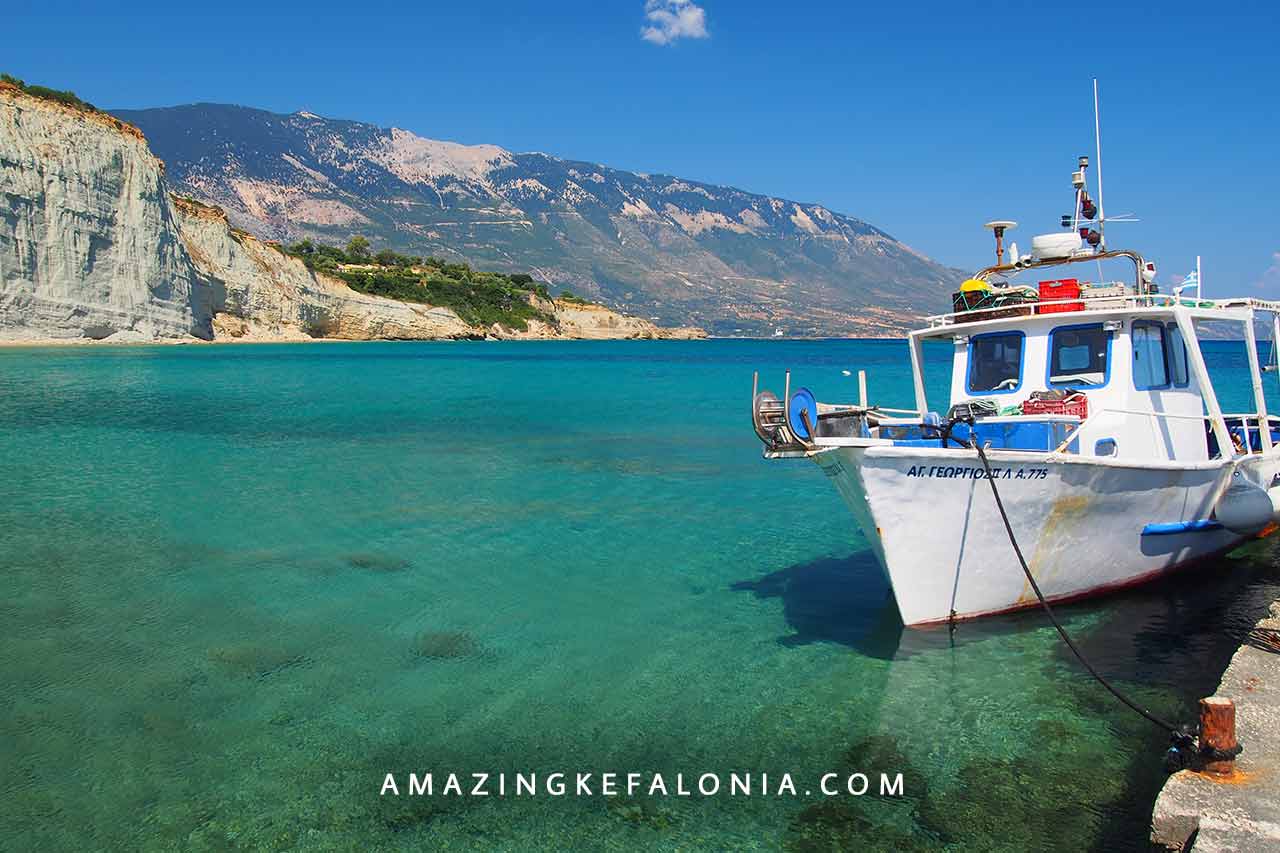
If you read this extremely detailed article about the weather of Kefalonia island (Cephalonia), you can plan the days of the holiday even better, and you will get the answers what are thew best periods for travel, for swim in the Ionian Sea or for sightseeing.
Kefalonia weather in Winter months (December – February)
While winters in the weather of Kefalonia (Cephalonia) are mild compared to northern Europe, they’re typically marked by cool temperatures and considerable rainfall. December through February sees daily high temperatures ranging from 12°C to 15°C (54°F to 59°F), while nights cool down to around 5°C to 8°C (41°F to 46°F). The winter months are the island’s wettest period, with January often receiving up to 120 mm of rain. This rainfall sustains Kefalonia’s rich greenery, allowing wild herbs, grasses, and flowers to flourish.
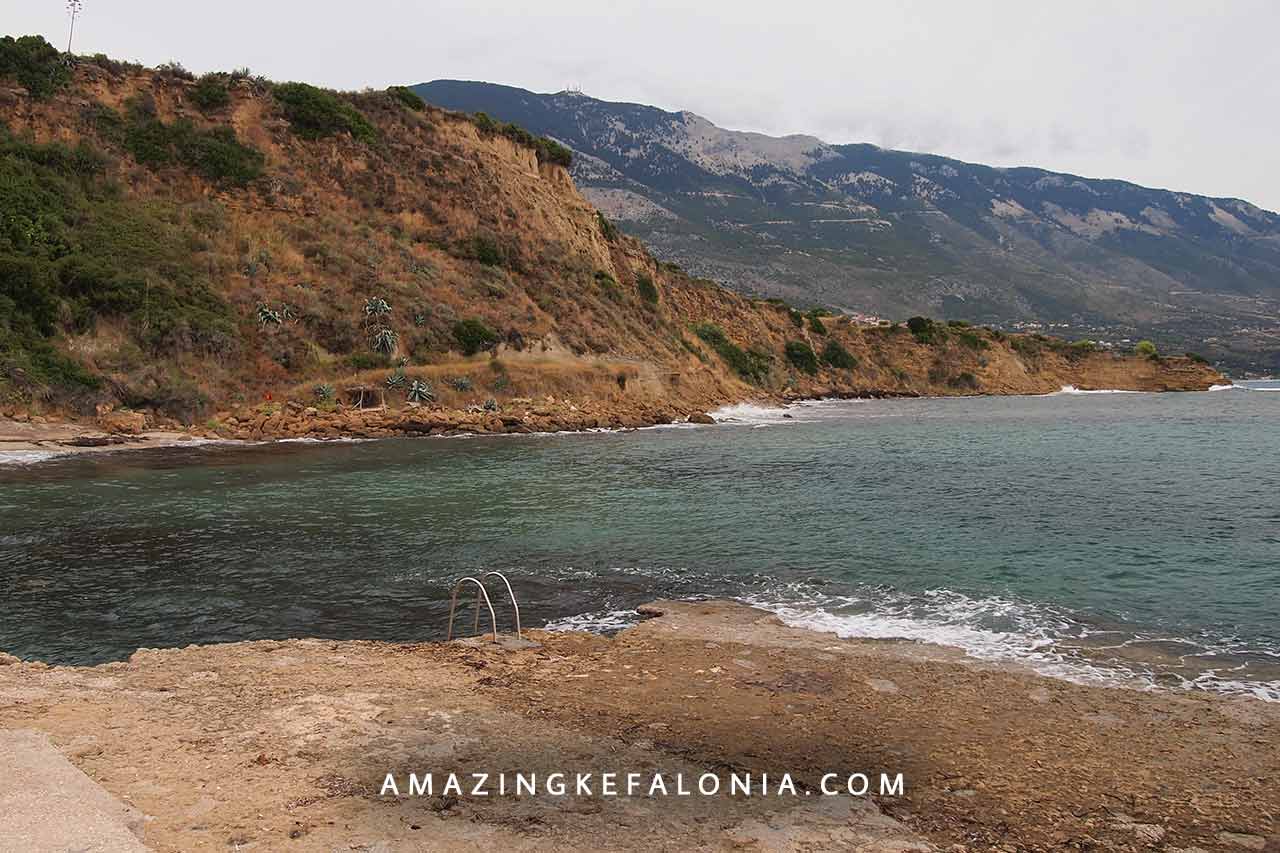
Occasionally, winds from the northwest sweep through, especially along the coastline, adding a noticeable chill. Snowfall is rare on Kefalonia, limited mainly to the higher elevations of Mount Ainos, but misty mornings and overcast skies lend a mysterious, serene atmosphere that draws in those looking for a peaceful winter escape. Sea temperatures are the lowest in the year in Kefalonia, and the Ionian Sea is usually turbulent – swimming is not an option in this period.
What to Do in Kefalonia in winter: for visitors who don’t mind rain and cool weather, some days of winter can be acceptable for exploring Kefalonia’s historical sites, villages, and monasteries without crowds.
January, the peak of Winter in kefalonia
January is peak winter for Cephalonia. The weather is usually cold yet, especially by Greek standards, with a humid and wet environment due to the island’s Mediterranean location.
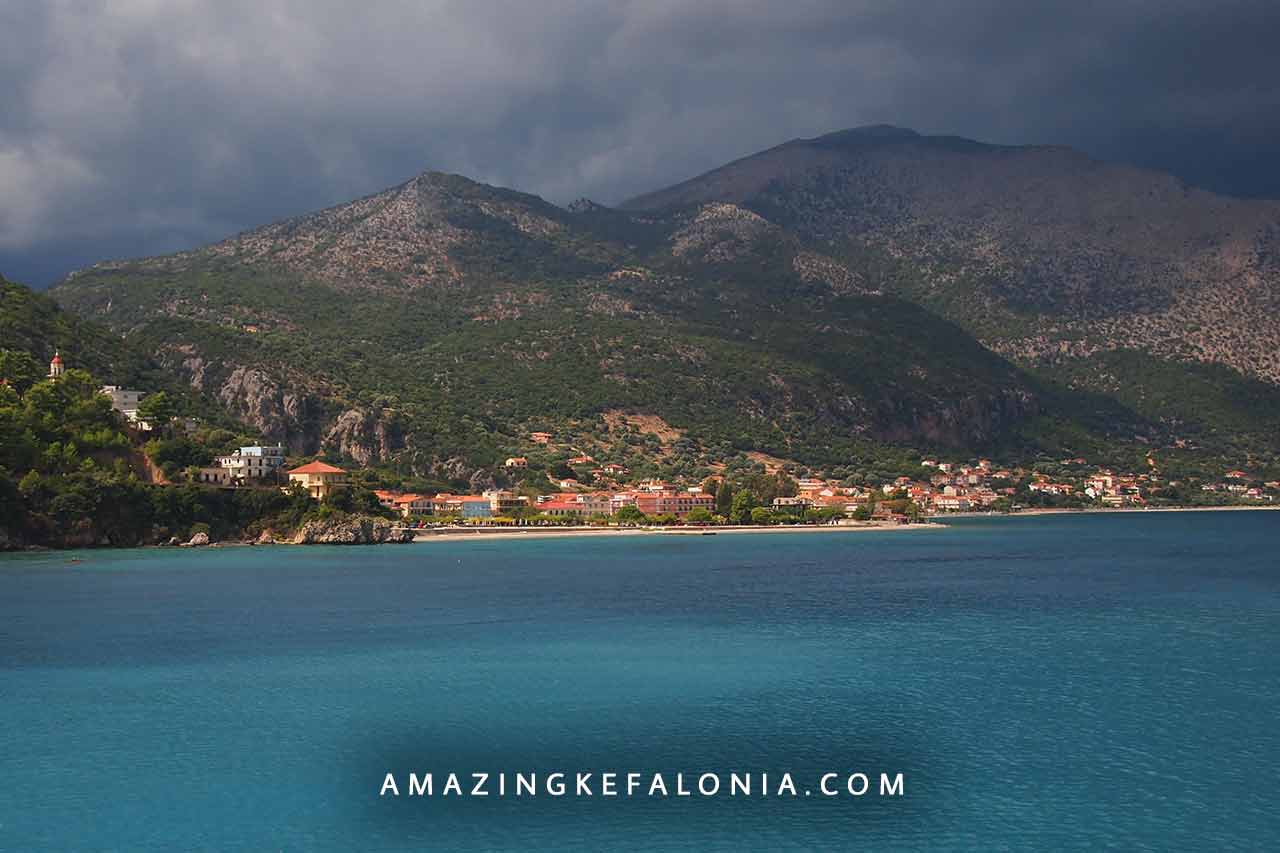
- Temperature: Daily highs average between 12°C and 14°C (54°F–57°F), with lows around 6°C to 8°C (43°F–46°F) at night. Mornings often feel especially cold, with a brisk chill from humidity.
- Precipitation: January is among the wettest months, with rainfall averaging around 120 mm. Rain is frequent, creating a lush landscape that begins to shine in green.
- Winds: North-westerly and south-westerly winds are common, often gusting to above 40 km/h. These winds can make the air feel colder, especially in the early mornings and late evenings.
- Cloud Cover: Cephalonia experiences heavy cloud cover, with only brief sunny intervals. The clouds contribute to a mysterious ambiance over the island, especially when rain threatens.
- Humidity: Humidity hovers high, typically around 75-85%, intensifying the cold and creating dampness, particularly in the island’s valleys and coastal areas.
- Natural Impact: January’s moisture supports vegetation, feeding the landscape and encouraging the growth of grasses and winter wildflowers.
- Sea temperatures in January: average sea temperature: 15°C
In January, Kefalonia’s waters are at their coldest. The winter chill is setting in, and the sea has fully transitioned from the warmer autumn months. Winter storms can influence local waters, adding occasional temperature fluctuations, but generally, temperatures stay within this range, so swimming is not an option in January in Kefalonia Island.
February, signs of a subtle shift in the weather
While February remains distinctly wintery, there’s a gradual warming, indicating the approaching end of winter.
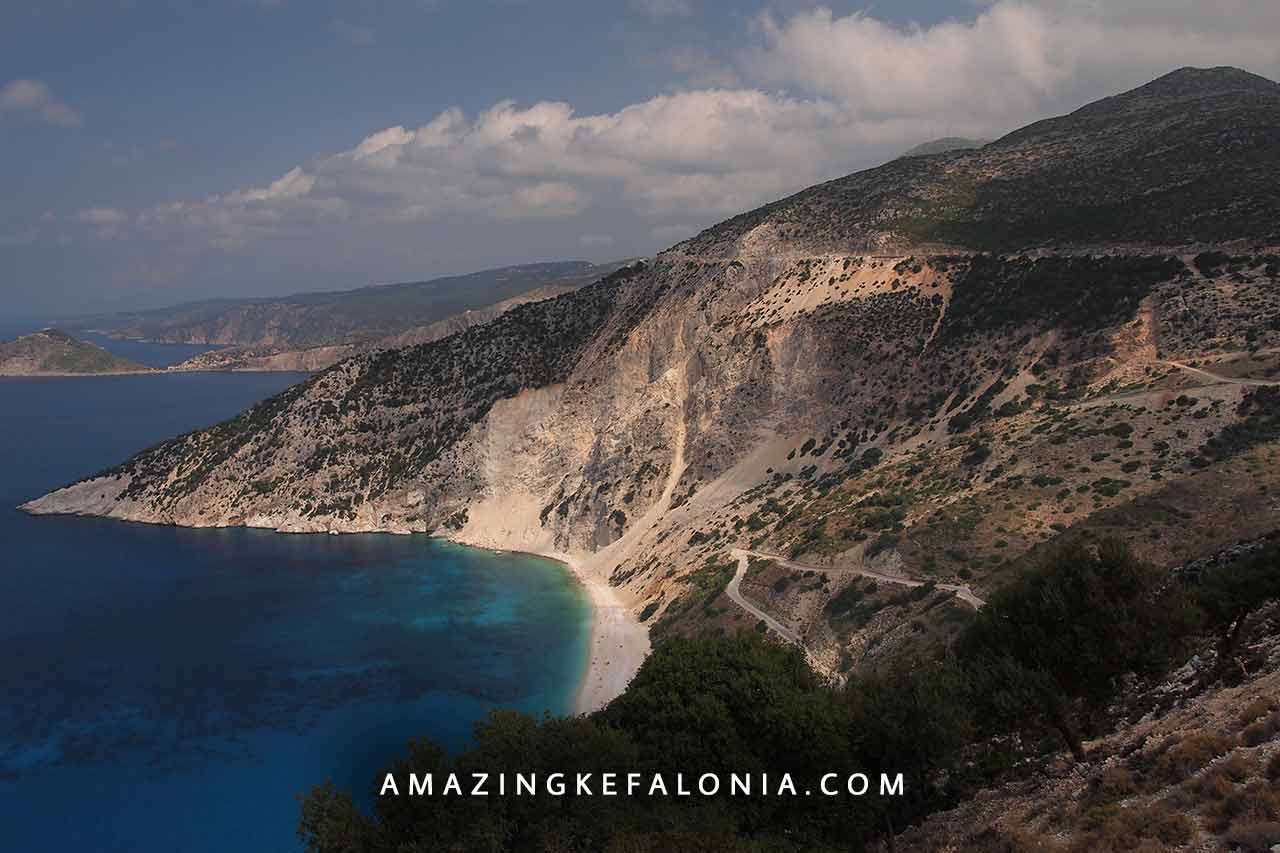
- Temperature: Temperatures rise slightly, with daytime highs averaging 13°C to 15°C (55°F–59°F), while nighttime lows hover between 7°C and 9°C (45°F–48°F).
- Precipitation: Rain is still common, though February averages around 100 mm of rain, which is slightly less than January. The showers may be lighter and interspersed with clearer skies.
- Winds: Strong winds continue, but as spring nears, there’s a slight moderation. The winds often shift to the west, bringing occasional bursts of colder air.
- Humidity: Humidity remains around 75%, giving the air a heavy feel that’s typical in winter.
- Natural Impact: February’s weather sets the stage for the island’s plant life to continue thriving. The soil remains saturated, ready to support the island’s ecosystem as it prepares for spring.
- Sea temperatures in February: average sea temperature: 14°C
February is typically the coldest month for Kefalonia’s sea, dipping to around 14°C. The surrounding air temperature remains low, which prevents the sea from warming up. Just a few swimmers venture in, as waters can feel very biting even with wetsuits. This month’s chill maintains the water’s lowest point of the year, with spring’s warmth just starting to be felt by the end of the month.
Kefalonia weather in Spring (March – May)
Spring in Kefalonia is a vibrant season, bringing warmer temperatures and longer days, with the landscape bursting into color as wildflowers bloom across the hills and valleys. March starts with daytime temperatures around 16°C (60°F), climbing steadily to around 22°C (72°F) by May. Nights also warm up, ranging from 8°C (46°F) in March to around 14°C (57°F) in May.
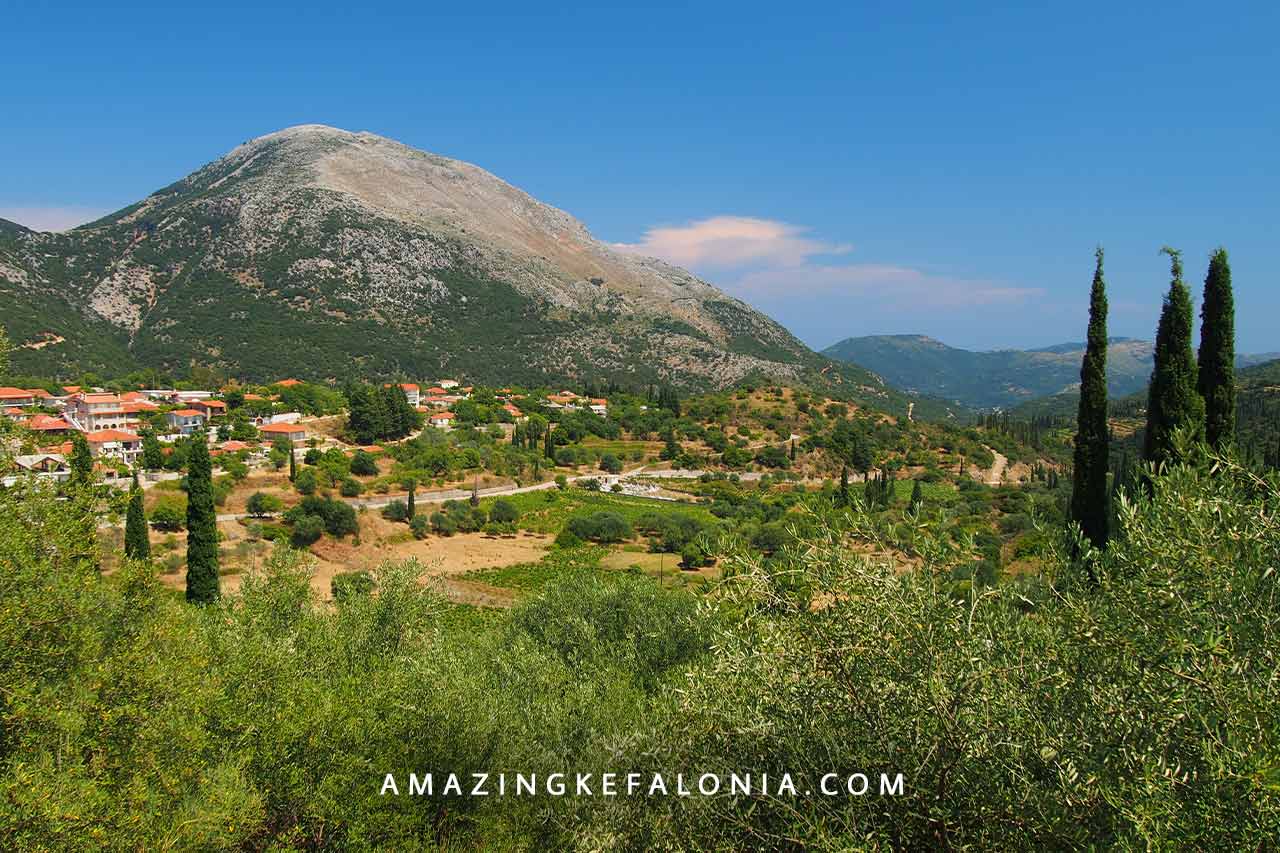
Rainfall decreases significantly as spring progresses, transforming April and May into slightly drier months. While early spring sees some occasional showers, the sunshine soon becomes more dominant, allowing visitors to enjoy the outdoors comfortably. But don’t forget, the rains are quite common in the weather of spring in Kefalonia.
In Kefalonia sea temperatures are getting higher slowly during Spring months, but in March and in April the sea is cold for most of the people. From the middle of the month you can see the first swimmers, when the sea temperature rises above 20 Celsius. In the end of May some of the shallow bays in the southern areas sea temperatures can be up to 22-23 Celsius, depending on actual weather conditions.
What to Do in Kefalonia in Spring: Spring is perfect for nature enthusiasts, as Kefalonia’s countryside is at its most beautiful. Hiking trails around Mount Ainos and coastal paths offer spectacular views and fragrant blossoms, and birdwatching becomes popular as migratory species make their appearance. By late spring, the local beaches become inviting enough for sunbathing and even swimming on warmer days in May.
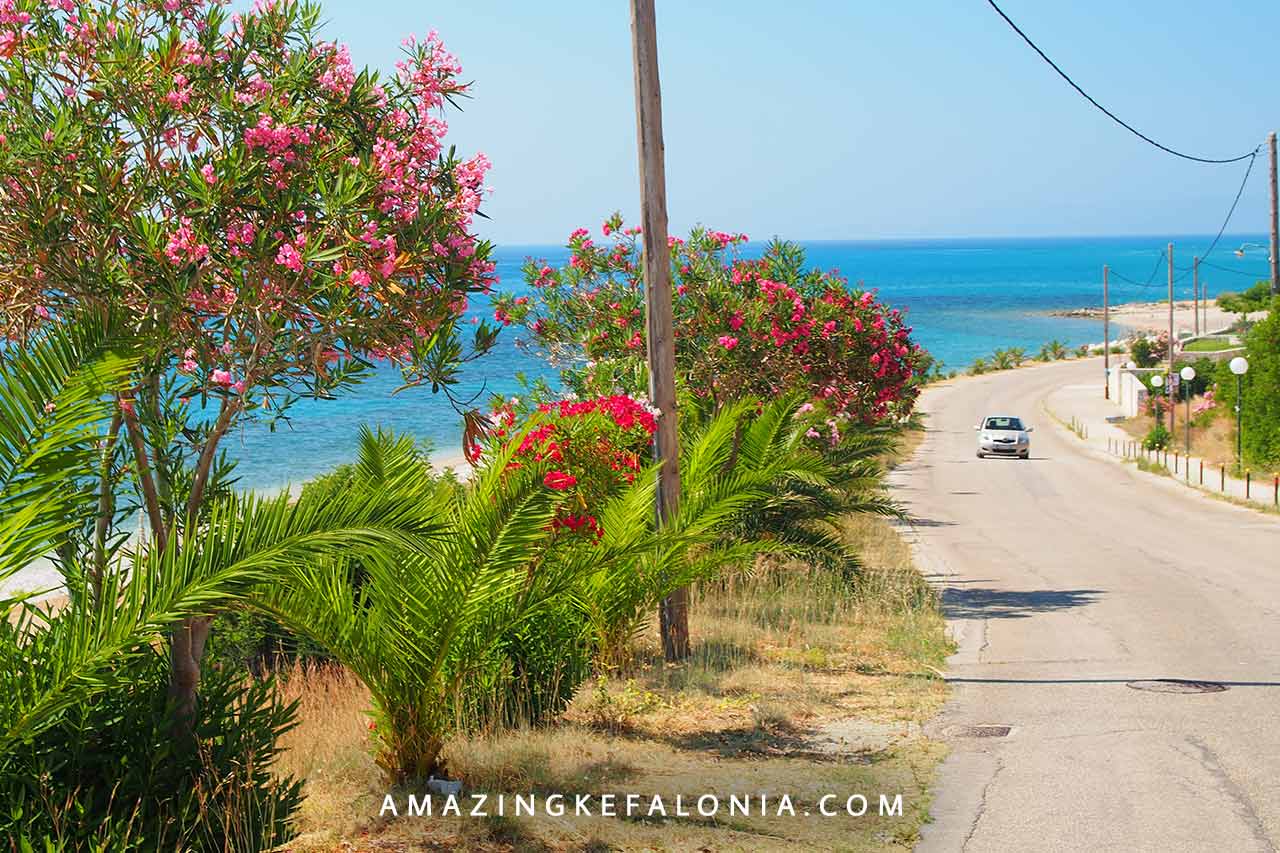
March, when the Spring begins in the weather of Kefalonia
March is the month where the weather of Kefalonia Island starts to transition out of winter. The days are longer, and the island experiences more sunlight.
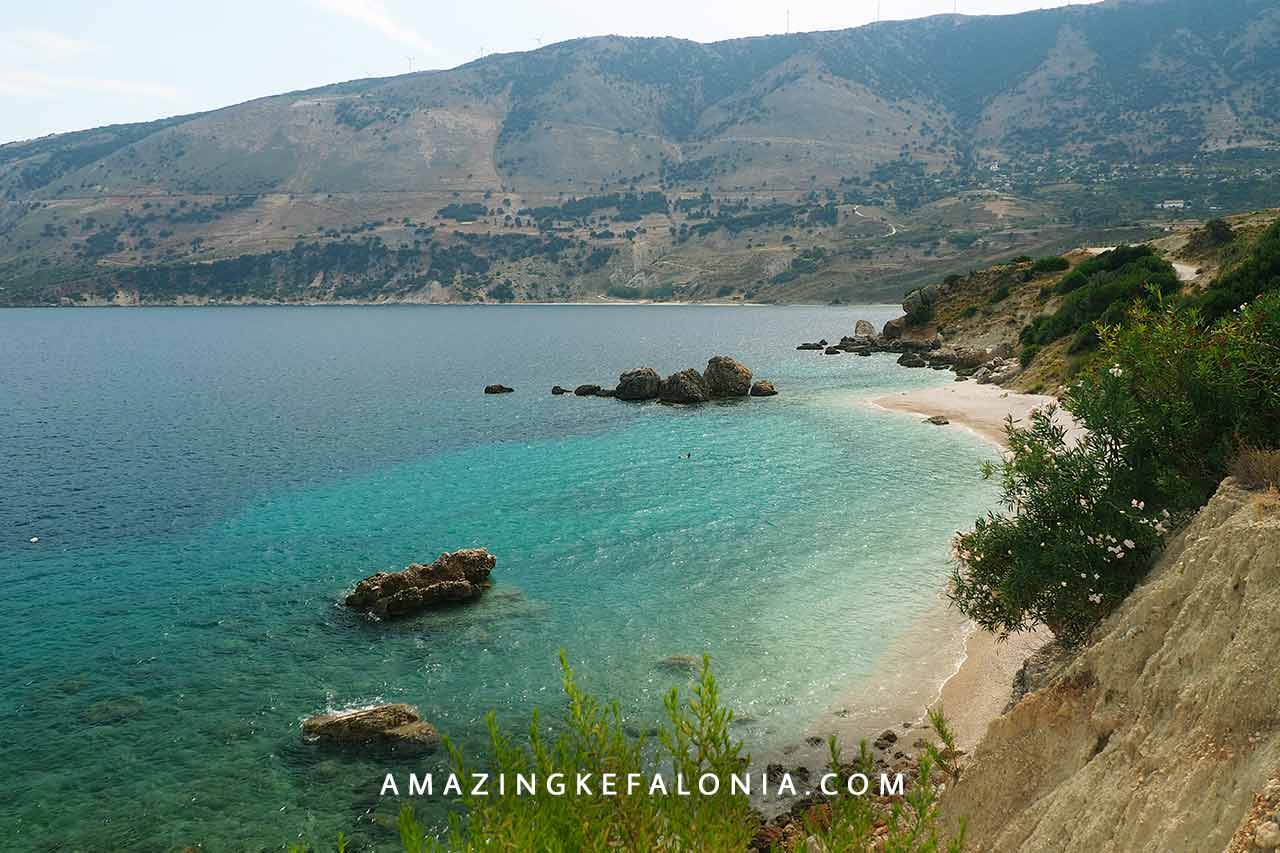
- Temperature: Daytime temperatures rise to about 16°C–18°C (60°F–64°F), with nighttime lows at 8°C–10°C (46°F–50°F). This warming trend helps bring a new energy to the island.
- Precipitation: Rainfall decreases slightly, with about 80 mm for the month. Rain showers are less intense and more sporadic, signaling the seasonal shift.
- Winds: Winds are generally lighter, although occasional gusts still pass through, particularly on the coastal areas.
- Sunlight: The sun appears more frequently, with daylight hours extending, allowing for more warmth during the day.
- Humidity: Humidity remains close to 70%, but the warmer temperatures balance the damp feel, making the air feel fresher.
- Natural Impact: The island’s flora begins to come alive in March, as the combination of rain, sunlight, and warmer temperatures encourages growth. Trees start to bud, and wildflowers dot the landscape in vibrant colors.
- Sea temperatures in March: average sea temperature: 15°C – 16 °C
In the weather of Kefalonia in March maintains a similar temperature to February, with the waters hovering around 15°C. Though it’s still very cool, the gradual lengthening of days means the sea temperature begins its slow climb. In March, the sea tends to feel less affected by sharp weather changes and shows more consistency. For local marine life, the weather of March marks a period of subtle transition as waters begin to warm.
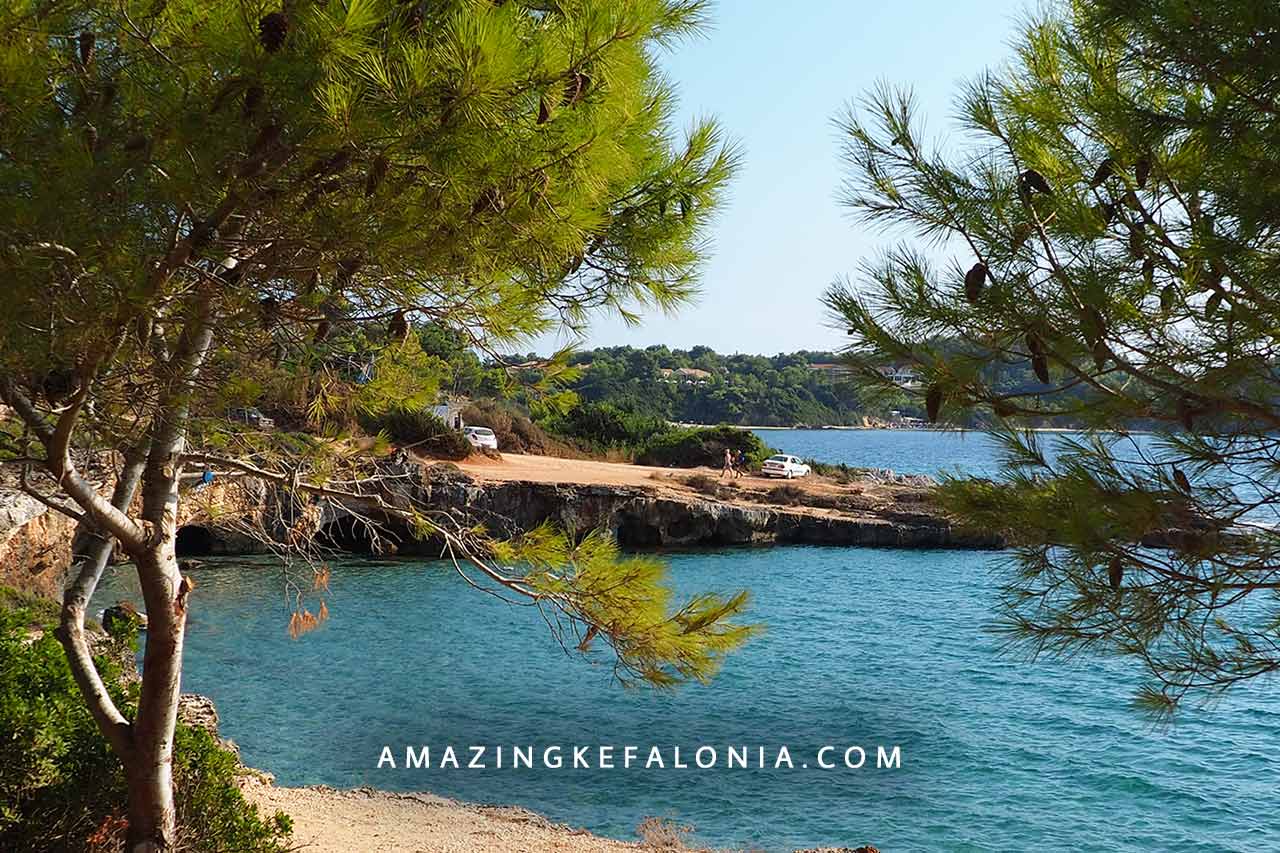
April weather, the true spring starts in Kefalonia
April brings a complete shift to spring in Kefalonia weather, with comfortable temperatures and fewer rainy days. This period is when Cephalonia begins to draw in more visitors, as the landscape is lush and the weather is mild.
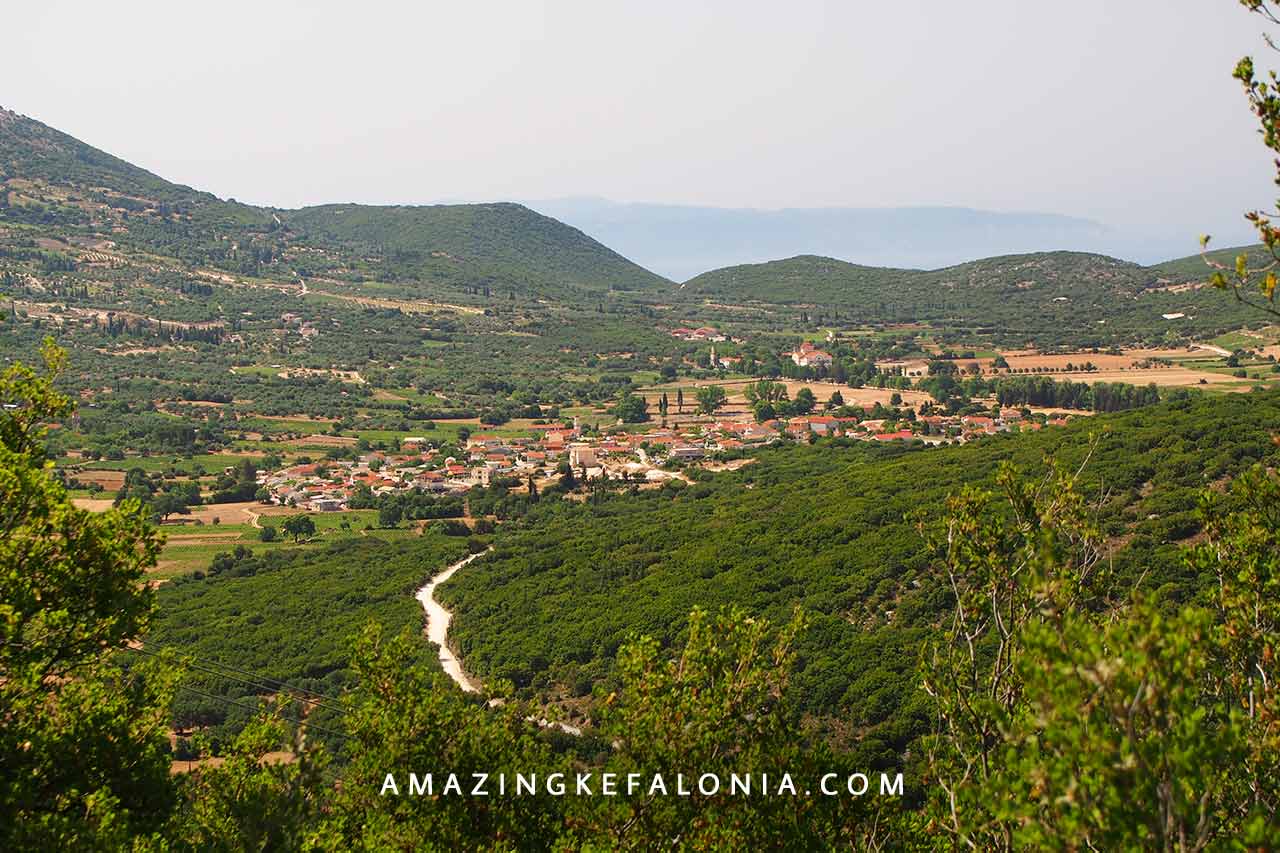
- Temperature: Temperatures climb to a comfortable range, with daytime highs around 18°C–20°C (64°F–68°F) and cooler nights at around 10°C–13°C (50°F–55°F).
- Precipitation: Rain is infrequent, with April averaging about 40 mm. Short, sporadic showers still happen, but they’re often light and brief.
- Winds: The winds are gentler, mainly coming from the south. Coastal breezes add to the mild ambiance, especially in the afternoons.
- Sunlight: Clearer skies dominate, with longer daylight hours as the season progresses, allowing for more outdoor activities.
- Humidity: Humidity levels lower, with an average of around 65%. The air feels fresh, and dampness gives way to a drier feel.
- Natural Impact: The island is in full bloom, with a variety of wildflowers and blossoms covering the hillsides. Birds and other wildlife are more active, and the island is a haven of biodiversity.
- Sea temperatures in April: average sea temperature: 16°C – 17°C
In the weather of April, the Ionian Sea starts to warm up, reaching around 17°C. The water still feel very cold to casual swimmers in Kefalonia island! The clarity of the water improves, as spring’s calm weather brings fewer disturbances in april.
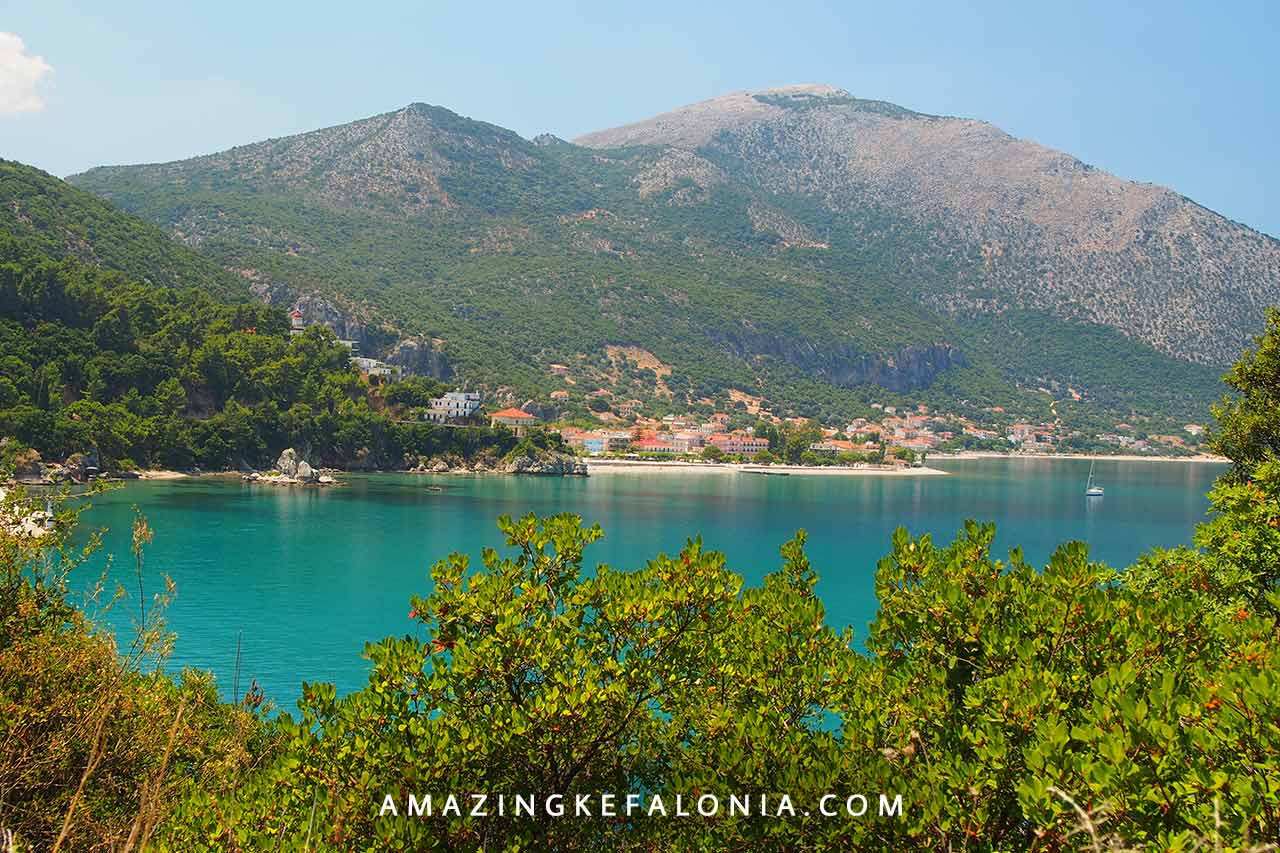
May weather in Kefalonia, blossoming early summer
May brings the start of early summer to Kefalonia’s weather. Temperatures are warm, rain is rare, and the island becomes a hotspot for visitors looking to experience the Ionian beauty.
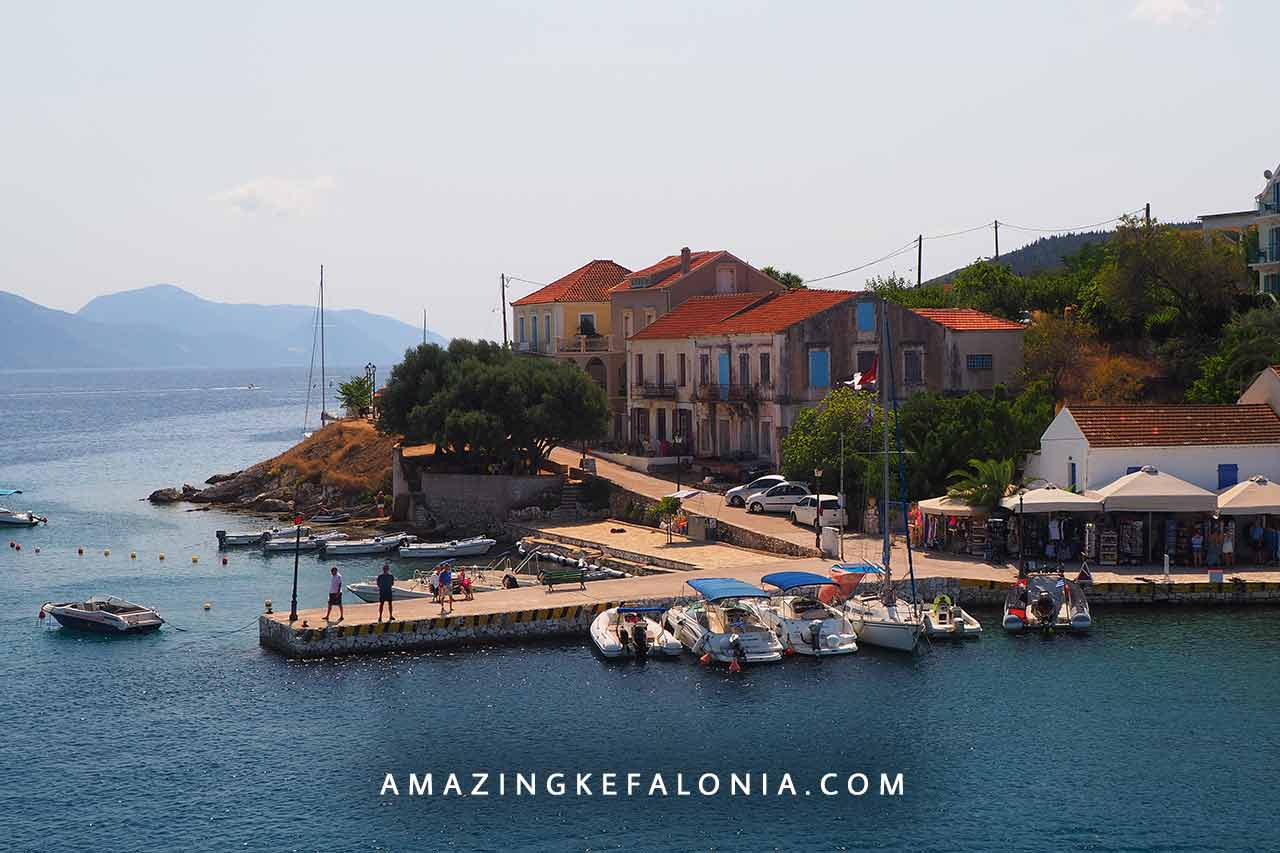
- Temperature: Daytime temperatures rise significantly, reaching 22°C–25°C (72°F–77°F) with evening lows around 14°C–16°C (57°F–61°F).
- Precipitation: May is one of the driest months, with rainfall averaging just 20 mm. Brief showers may still occur but are typically rare and short-lived.
- Winds: Light, steady breezes blow predominantly from the south, providing mild, refreshing air that makes the warm temperatures pleasant.
- Sunlight: Sunlight is abundant, with May offering some of the longest days of the year. The increased daylight highlights the beauty of the island’s beaches and landscapes.
- Humidity: Humidity is low at around 60%, with clear skies and warm, dry air that creates ideal conditions for sightseeing and beach days.
- Natural Impact: The green landscapes of spring transition into the golden hues of early summer. Trees and vegetation are lush, but with the dry weather, some plants begin to develop more drought-resistant characteristics.
- Sea temperatures in May: average sea temperature: 19°C – 21 °C
In May, the waters warm up significantly in Kefalonia Island, reaching 19°C – 21 °C, depending on actual location. The weather in May starts the island’s tourist season, as visitors can begin to enjoy pleasant beach days. While sea temperatures are still cool, this temperature is comfortable enough for some swimming for some people, especially during sunny days when the shallow water areas warm up quicker. Many locals consider the end of May is starting the swim season, when the sunbeds and parasols are put out on the beaches of the island.
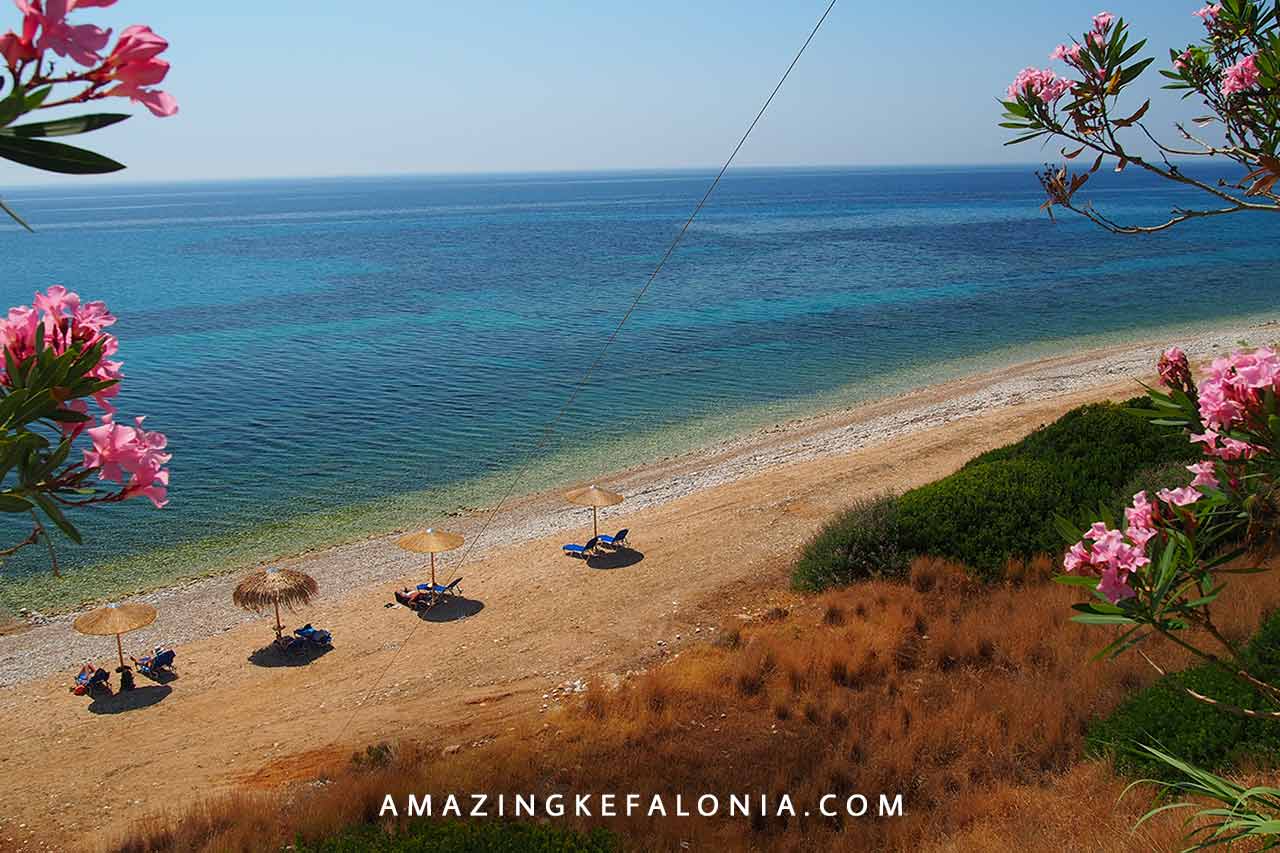
Kefalonia weather in Summer months (June – August)
The weather of Kefalonia in summer is warm, dry, and sun-drenched, drawing visitors eager to relax by the crystal-clear waters of the Ionian Sea. June marks the start of summer with average highs around 28°C (82°F), but by July and August, daytime temperatures often reach 30°C to 35°C (86°F to 95°F). Evenings remain pleasant, with temperatures around 20°C to 24°C (68°F to 75°F), and the low humidity provides relief, keeping the air clear and comfortable.
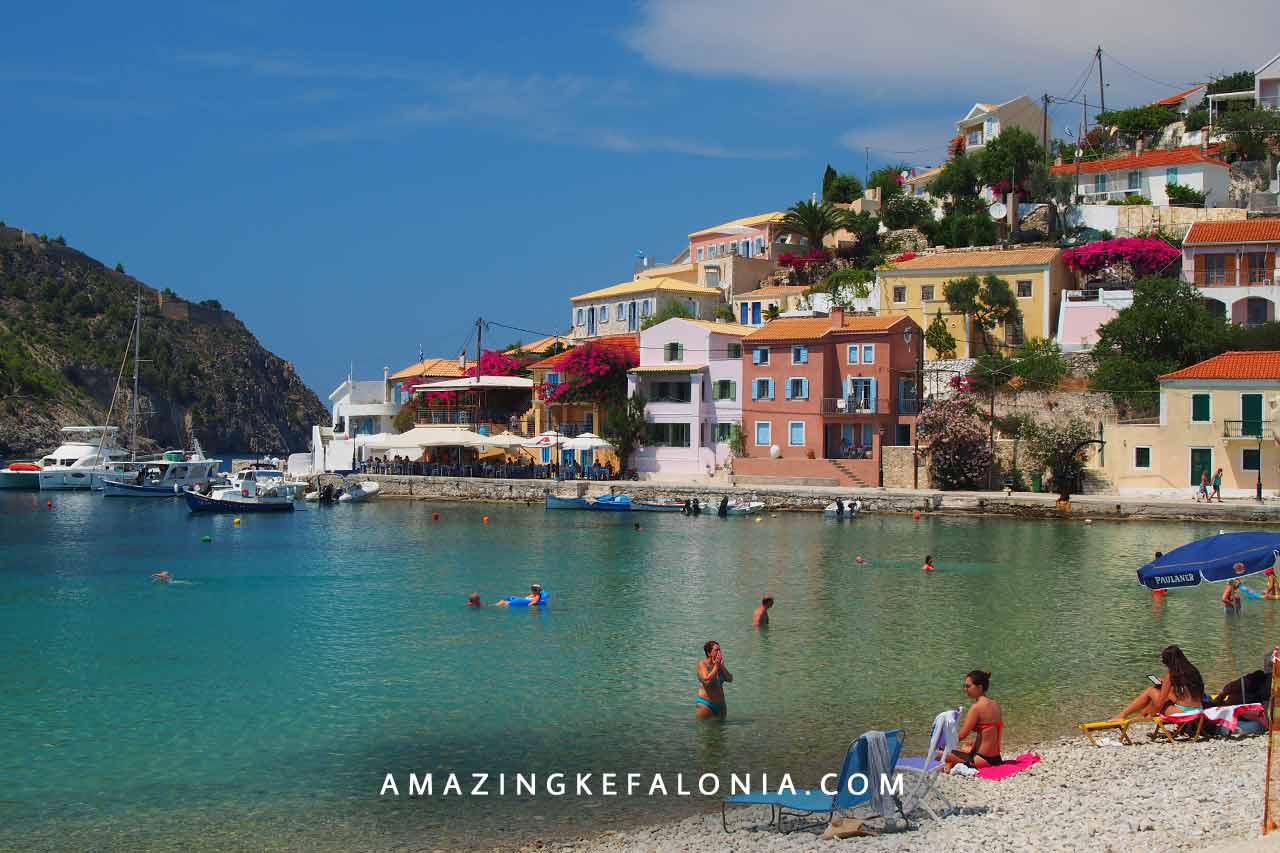
Rainfall is nearly nonexistent in summer months, with skies remaining bright and blue. Gentle coastal breezes from the northwest create ideal conditions for beachgoers, while the calm seas are perfect for boating, snorkeling, and other water activities.
Sea temperatures are the best from June to August, and most of the locals and the tourists enjoy the beach activities.
What to Do in Summer: Kefalonia’s beaches are the main attraction in summer, when the iconic Myrtos beach, the incredible Antisamos beach, the interesting Xi Beach, the long beaches of Lassi and Skala and other highlights offering stunning settings for swimming, sunbathing, and water sports. Boat tours are popular, with trips to neighboring islands and secluded beaches around Kefalonia. Summer evenings are lively, with cultural festivals, music events, and alfresco dining in Argostoli, Fiskardo, Assos and Agia Efimia adding to the island’s charm.
Click here for apartments and studios in Kefalonia island for best summer holidays!
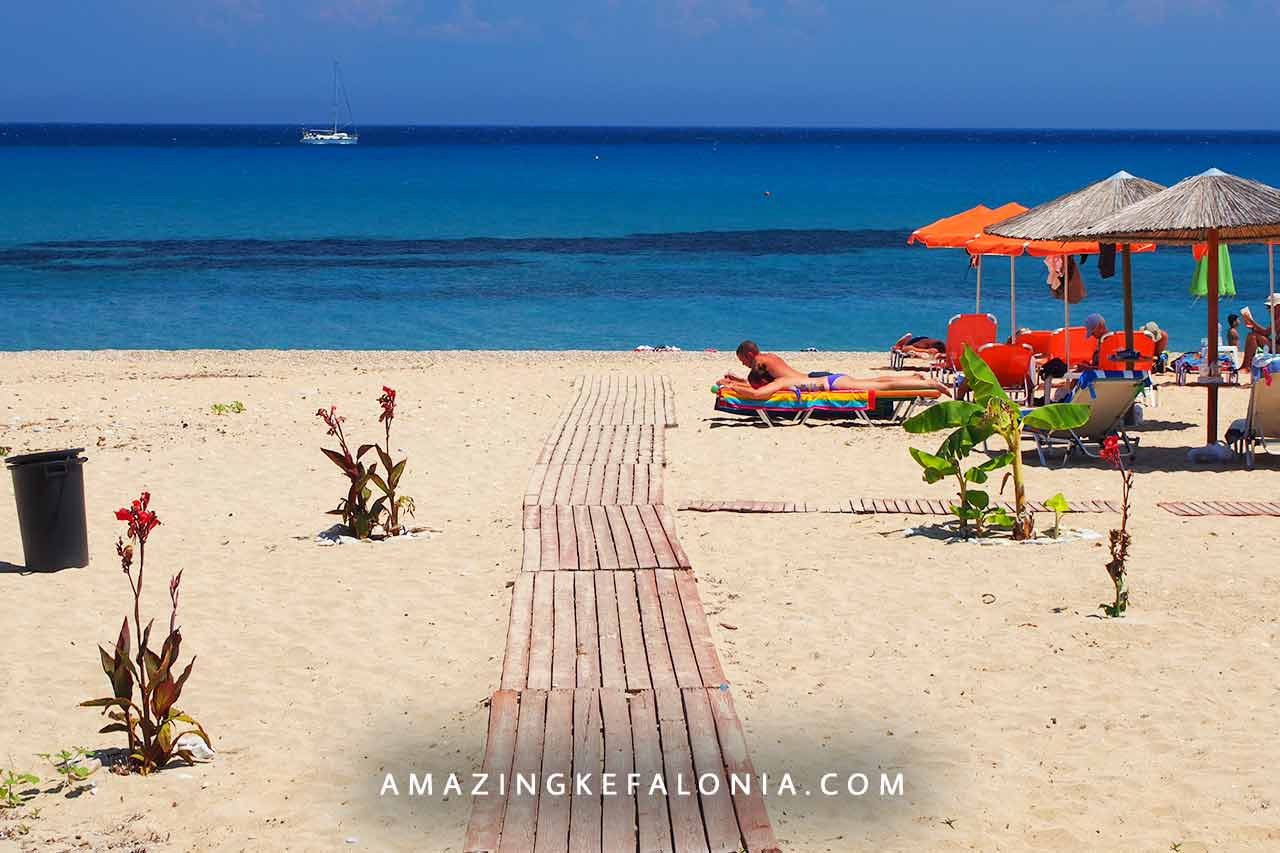
June weather in Kefalonia is the onset of summer
The weather of June in Kefalonia Island marks the arrival of full summer. The island is now bathed in warm, consistent sunshine, and the Mediterranean climate shines at its best. In Kefalonia weather June is usually a great months for everyone, who want to enhoy the benefits of preseason, when the beaches are not so crowded, the restaurants are open, and most of the services are operating.
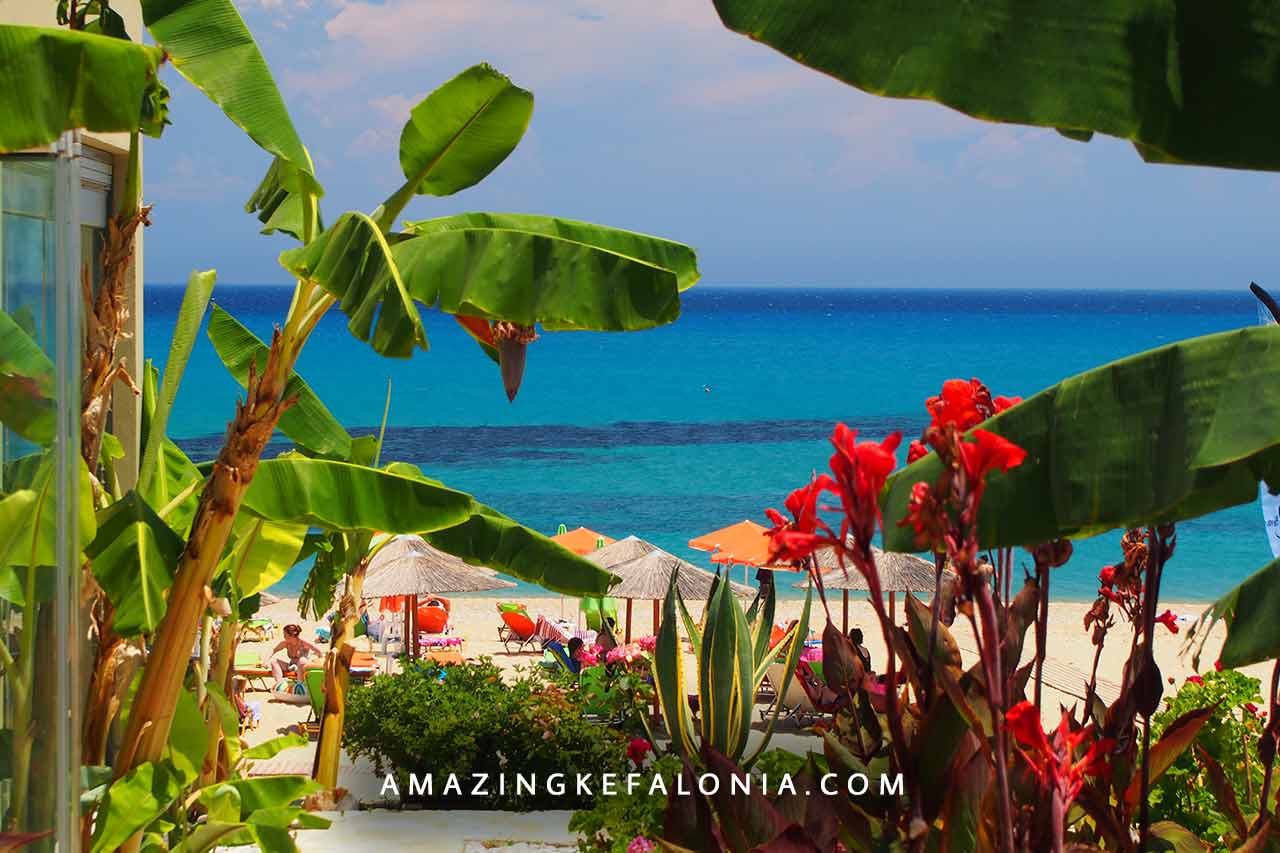
- Temperature: Temperatures reach summer levels, with highs around 26°C–33°C (79°F–86°F) during the day and mild nights at about 17°C–23°C (63°F–68°F).
- Precipitation: June is very dry, averaging less than 10 mm of rainfall. Days are almost exclusively sunny, and rain, if any, is brief.
- Winds: Gentle breezes continue, predominantly from the southwest, adding to the warm summer feel. This steady air movement creates ideal beach weather.
- Sunlight: June experiences the longest daylight hours, making it an excellent month for outdoor exploration.
- Humidity: Humidity is moderate, around 55%, which complements the high temperatures with a fresh, comfortable feel.
- Natural Impact: June’s dry and sunny conditions begin to influence the island’s vegetation, as greener landscapes start to transition to the golden hues typical of Mediterranean summers.
- Sea temperatures in June: average sea temperature: 23°C – 24°C
June marks the transition into summer, with sea temperatures rising to a pleasant 23°C. The sea becomes inviting, as the weather around the island is warmer and more consistent. The weather of June is ideal for swimming, diving, and all kinds of water sports. The increased sunlight and warming currents attract fish and marine life closer to the shores, providing vibrant underwater scenery for snorkelers.
From the middle of June sea temperatures in some shallow bays can rise up to 24°C – 25°C, which makes great water activities for children also.
Kefalonia in July, when the weather is sunny, hot, and dry
July weather in Kefalonia marks the height of summer, with the island experiencing consistently warm, dry, and sunny weather, making it one of the best months for beach activities and outdoor exploration. In July Kefalonia Island is getting more crowded, a lot of tourists arrive in this month by ferries and by planes. The squares and pedestrian streets of the villages are busy in the evenings, the people enjoy the atmospheres of the summer nights.
The early booking of an accommodation is mandatory for the summer months, because most of the apartments and hotels are reserved: click here to find your place for your holiday!
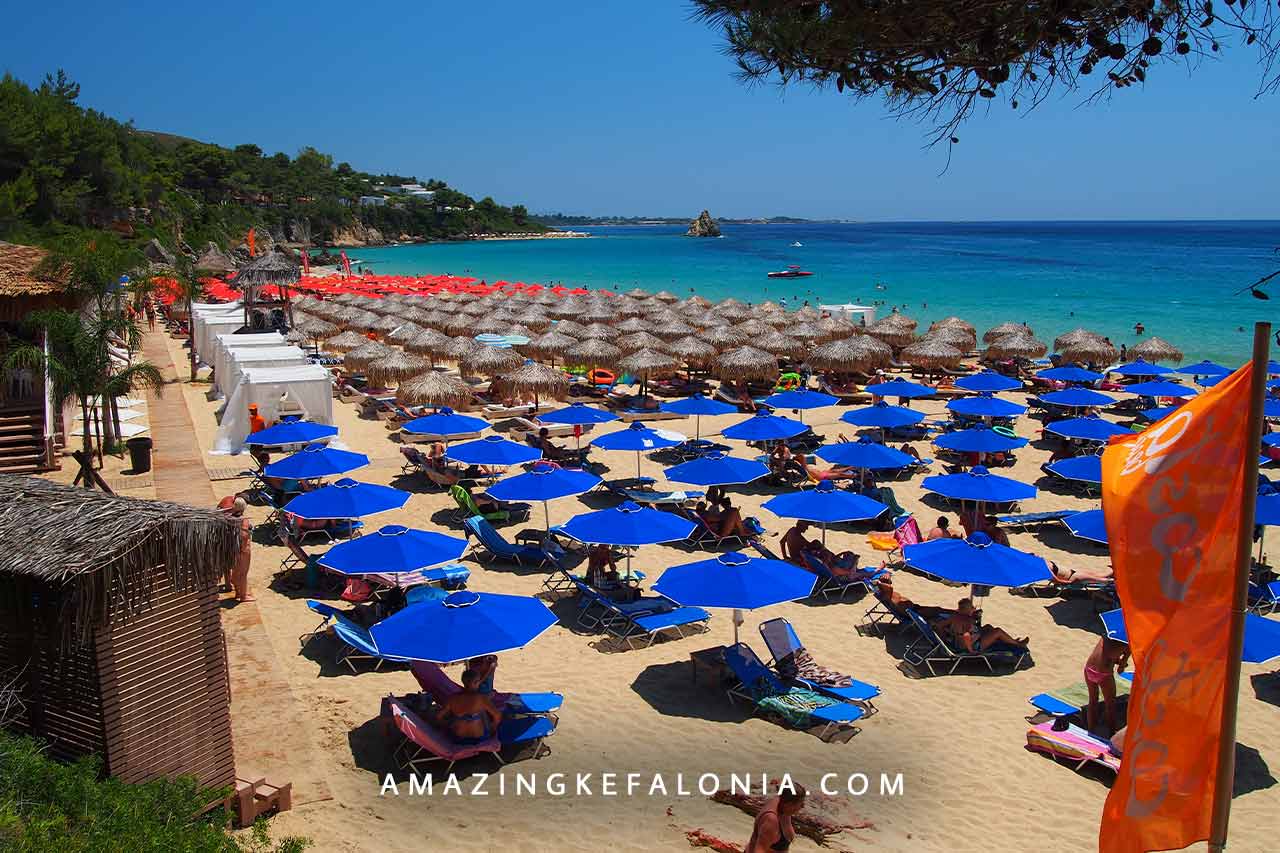
- Temperature: Daily highs regularly reach between 30°C and 36°C (86°F to 95°F), with nights cooling to around 22°C to 25°C (72°F to 75°F). The consistent warmth allows for enjoyable days at the beach and pleasant evenings.
- Humidity: Humidity levels remain moderate, generally around 50-60%, providing dry, comfortable air that complements the high temperatures.
- Rainfall: Rain is extremely rare, with the month averaging only a few millimeters, if any, making it one of the driest periods.
- Winds: Mild coastal breezes from the northwest help to keep the heat manageable, especially along the beaches.
- Natural Impact: The island’s landscapes shift to golden tones under the summer sun, with vegetation entering a period of dormancy due to the dry conditions.
- Tourism Influence: From the middle of July to middle of August is peak season, with tourists flocking to beaches like Myrtos and Antisamos. The warm, clear sea is ideal for swimming, snorkeling, and for boat trips around the island.
- Sea temperatures in July: average sea temperature: 25°C
By July, Kefalonia’s waters are comfortably warm at 25°C. July and August are the peak of summer and the peak of sea temperatures, making swimming conditions perfect for all ages. The water is consistently warm, calm, and clear due tue the weather of July. This is when Kefalonia’s beaches are most crowded, and swimmers can enjoy long days in the sea without feeling chilly. These stable and warm temperatures encourage marine biodiversity, with ample underwater visibility.
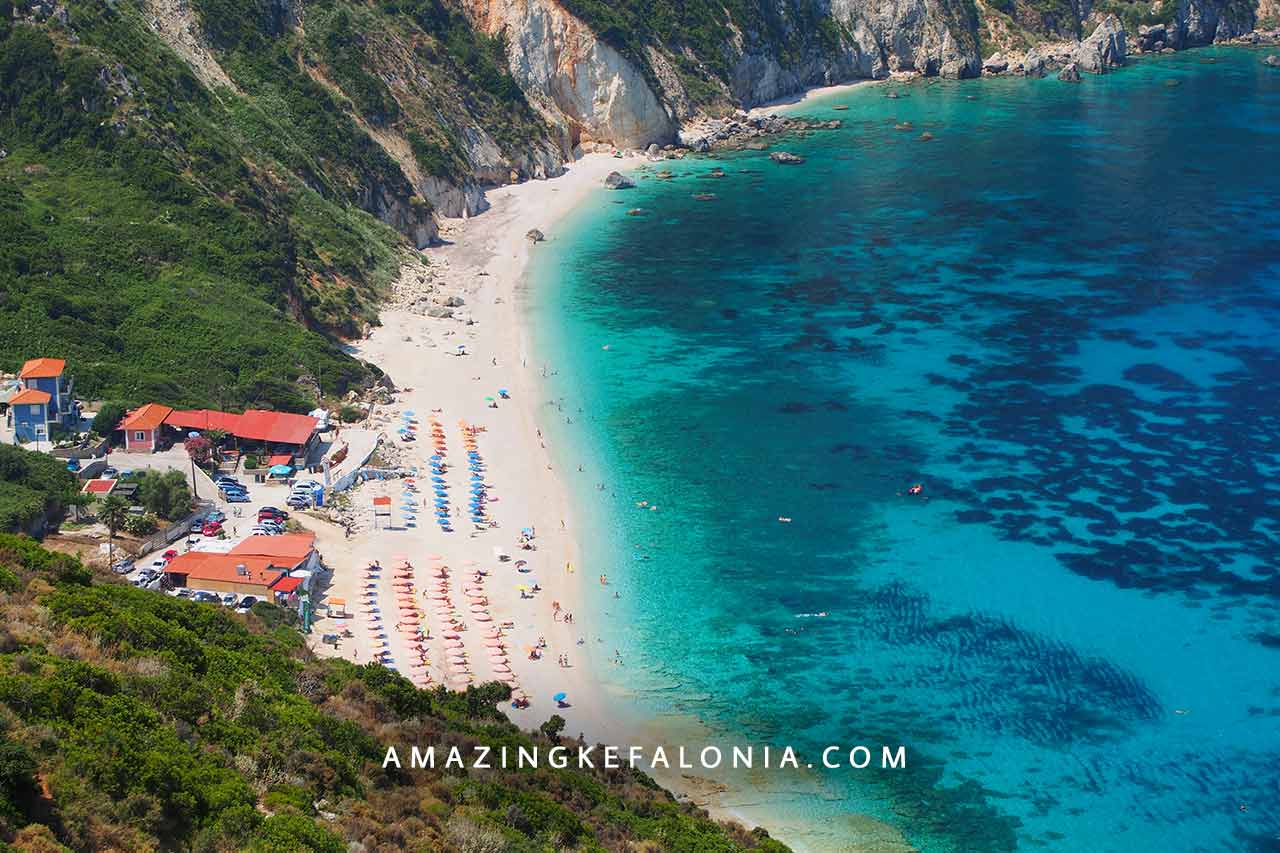
Kefalonia weather in August, Intense Sun and a Lively Atmosphere
The weather of Kefalonia in August continues the hot, dry conditions of July but is also the busiest month for tourism. The island’s climate and atmosphere are at their most vibrant. The local beaches are filled in August, especially the most popular beaches are crowded. Even the long beaches of Lassi, Skala, Lourdata and the famous ones such as Myrtos beach, Antisamos beach, Xi beach are getting filled in the morning hours. The sun is very strong, the use of sunscreen is mandatory!
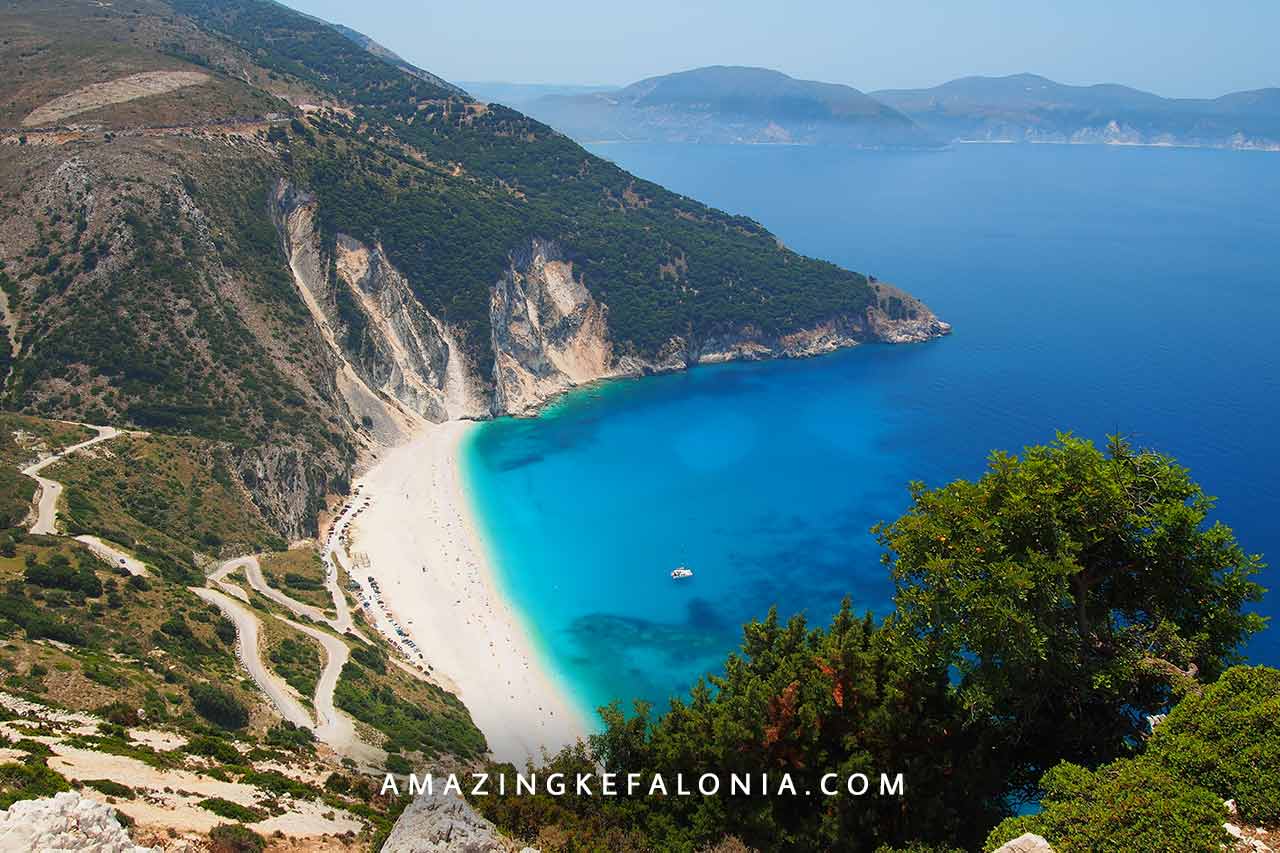
- Temperature: Daytime temperatures remain high, averaging 31°C to 37°C (88°F to 95°F), with nights cooling to around 22°C to 25°C (72°F to 77°F).
- Precipitation: Like July, August sees almost no rain, and the skies are consistently clear.
- Humidity: Humidity stays low, adding to the pleasantness of the summer heat and clear skies.
- Wind: Coastal breezes are still present, though they may be lighter than earlier in the summer, providing gentle airflow in the hot weather.
- Sunlight: The sun shines brightly, with almost no clouds, and days are long, allowing ample time for outdoor activities.
- Nature: The landscape has fully adapted to the dry summer, with golden hillsides and dusted mountain paths.
- Sea temperatures in August: average sea temperature: 26°C
August is the warmest month for Kefalonia’s sea, reaching an average of 26°C. This month’s calm and warm water draws snorkelers, divers, and swimmers from around the world. The combination of warm waters and peak sunlight means that swimming remains comfortable even into the late evening. The calm, warm conditions of the august weather are ideal for exploring underwater landscapes, as water clarity is optimal with minimal wave disturbance at several local beaches.
Visitor Tips: August is perfect for enjoying Kefalonia’s beach scene, as the sea is at its warmest. However, with high tourist numbers, it’s best to arrive early for popular spots. Cultural events and festivals are common in August, giving visitors a taste of Greek island traditions.
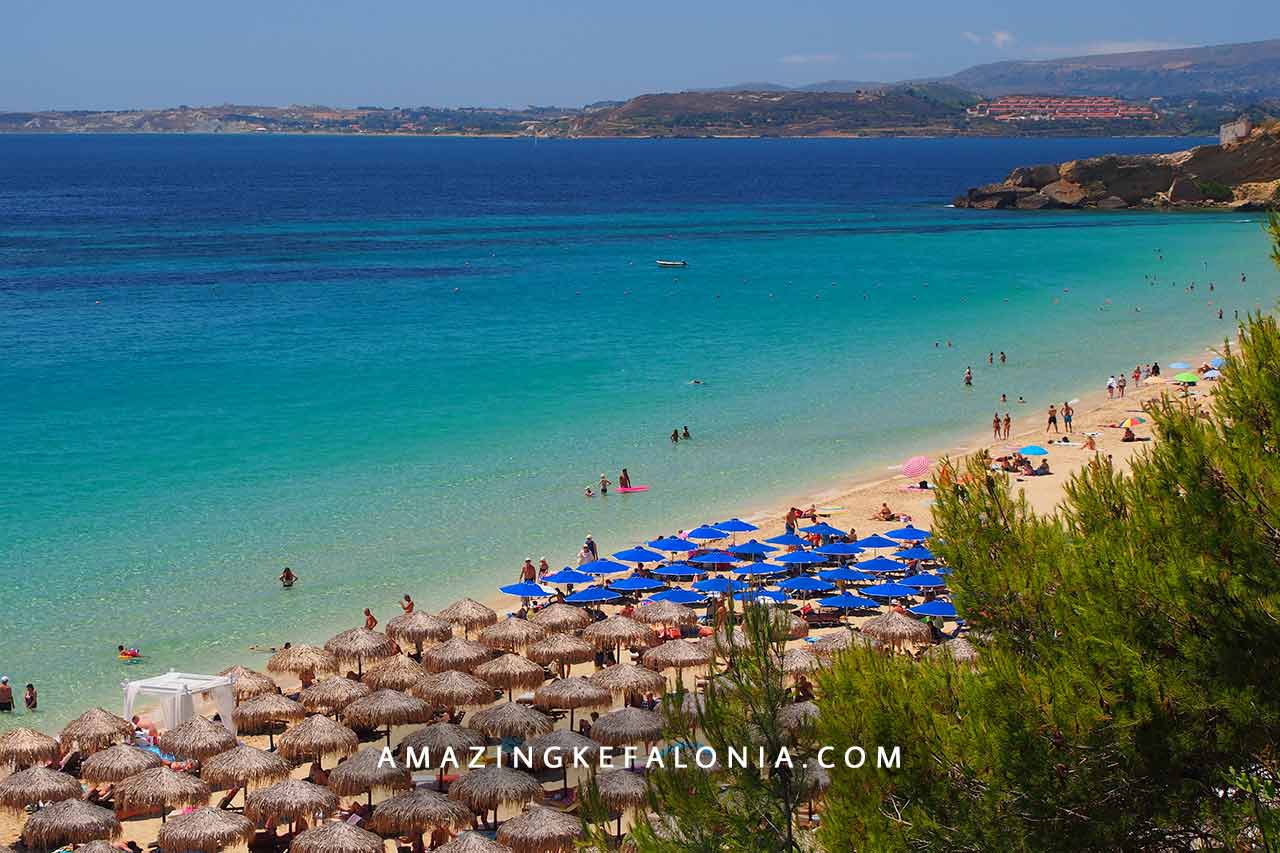
Kefalonia weather in Autumn (September – November)
Autumn weather in Kefalonia Island offers a gentle transition from the hot summer, with warm, sunny days and cooler nights. September retains summer-like temperatures, with highs around 28°C (82°F), but by November, daily highs drop to about 18°C (64°F). Nights are cooler, averaging between 12°C (54°F) in October and 10°C (50°F) in November.
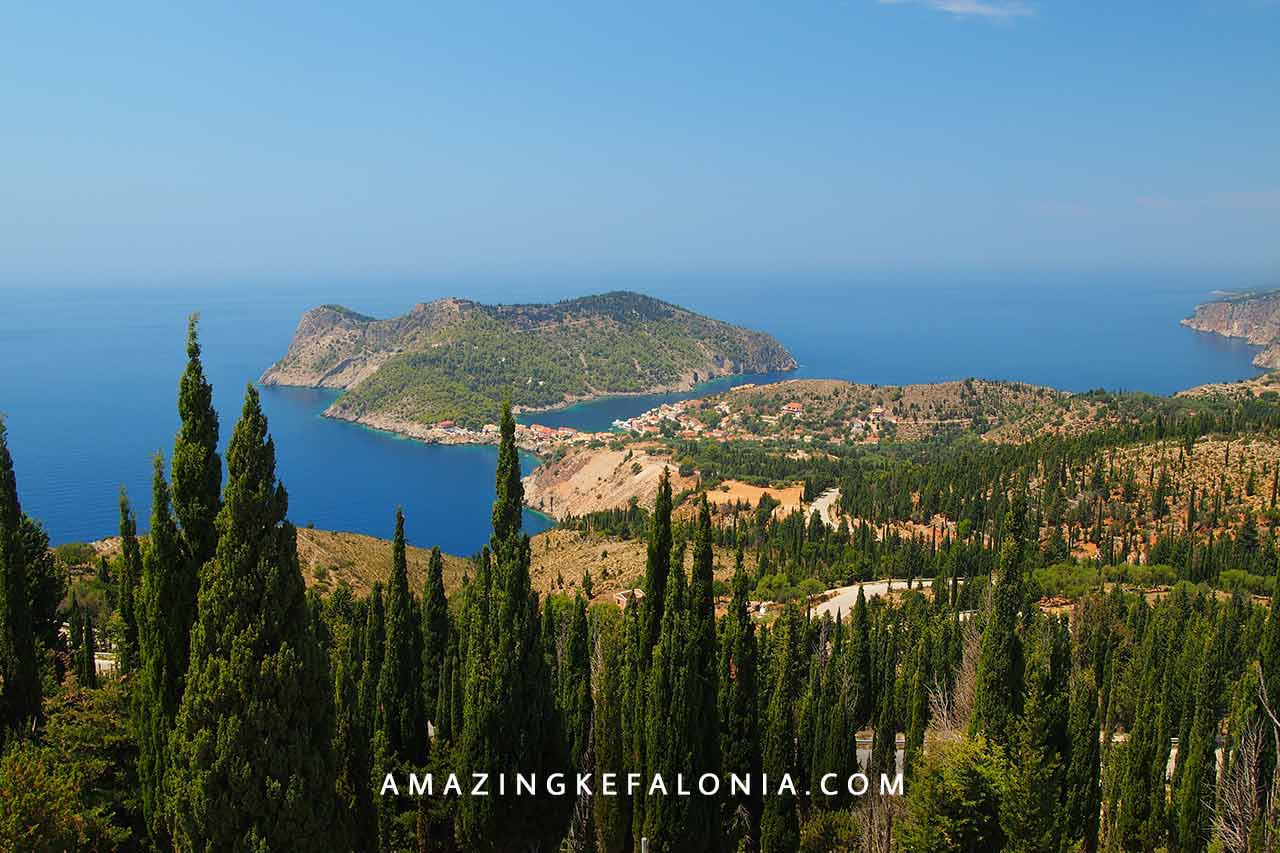
Early autumn sees very little rainfall, and it’s not until late October and November that the rainy season begins. With the return of precipitation, Kefalonia’s landscapes regain their green vibrancy after the dry summer months, and the island feels refreshingly renewed.
Usually sea temperatures are quite great till the end of September, which makes Kefalonia ideal for postseason holidays.
What to Do in Autumn: September is excellent for beach activities without the peak summer crowds, while October and November are ideal for hiking, exploring Kefalonia’s vineyards, and attending grape-harvest festivals. Mild temperatures make it comfortable for sightseeing, and the olive harvest season offers a unique chance to see local agricultural traditions in action.
September weather in Kefalonia, Warm Days, Fewer Crowds
September sees a gradual decrease in temperatures and a subtle shift towards autumn. The weather remains warm, but with the peak summer crowds diminishing.
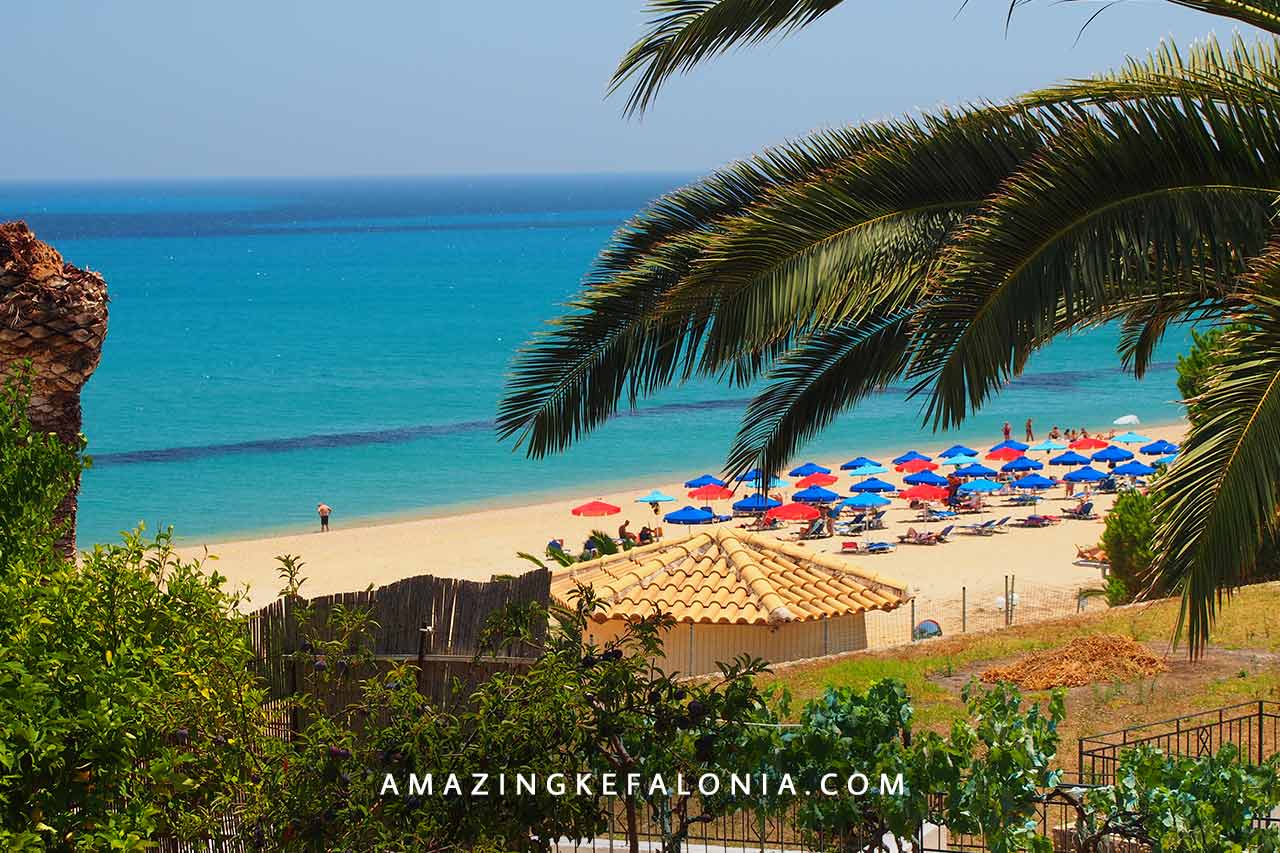
- Temperature: Daytime highs average around 27°C to 30°C (81°F to 86°F), with nighttime lows of 19°C to 22°C (66°F to 72°F).
- Precipitation: Rain is still rare, but brief showers might appear toward the end of the month.
- Humidity: Humidity levels begin to rise slightly, but the air remains comfortable, and the late-summer warmth is still palpable.
- Wind: Light coastal winds, predominantly from the west, help maintain the pleasant weather.
- Sunlight: While daylight hours shorten slightly, the weather is still ideal for outdoor activities, with plenty of sunny days.
- Nature: The dry landscapes of summer begin to subtly transform, with some areas regaining a hint of green as occasional moisture returns.
- Sea temperatures in September: average sea temperature: 25°C
September continues to offer warm waters, with temperatures averaging around 25°C. Though the summer crowds start to thin, the sea remains wonderfully warm. Many visitors favor September for its warm waters and fewer tourists. These temperatures make it ideal for extended swimming and water sports. Due to weather of september the marine life continues to thrive, offering some of the best snorkeling and diving experiences of the year.
Visitor Tips: September is a fantastic time for those seeking a warm beach vacation with fewer crowds. The water remains warm, and it’s a great month for hiking and nature walks in cooler morning hours.
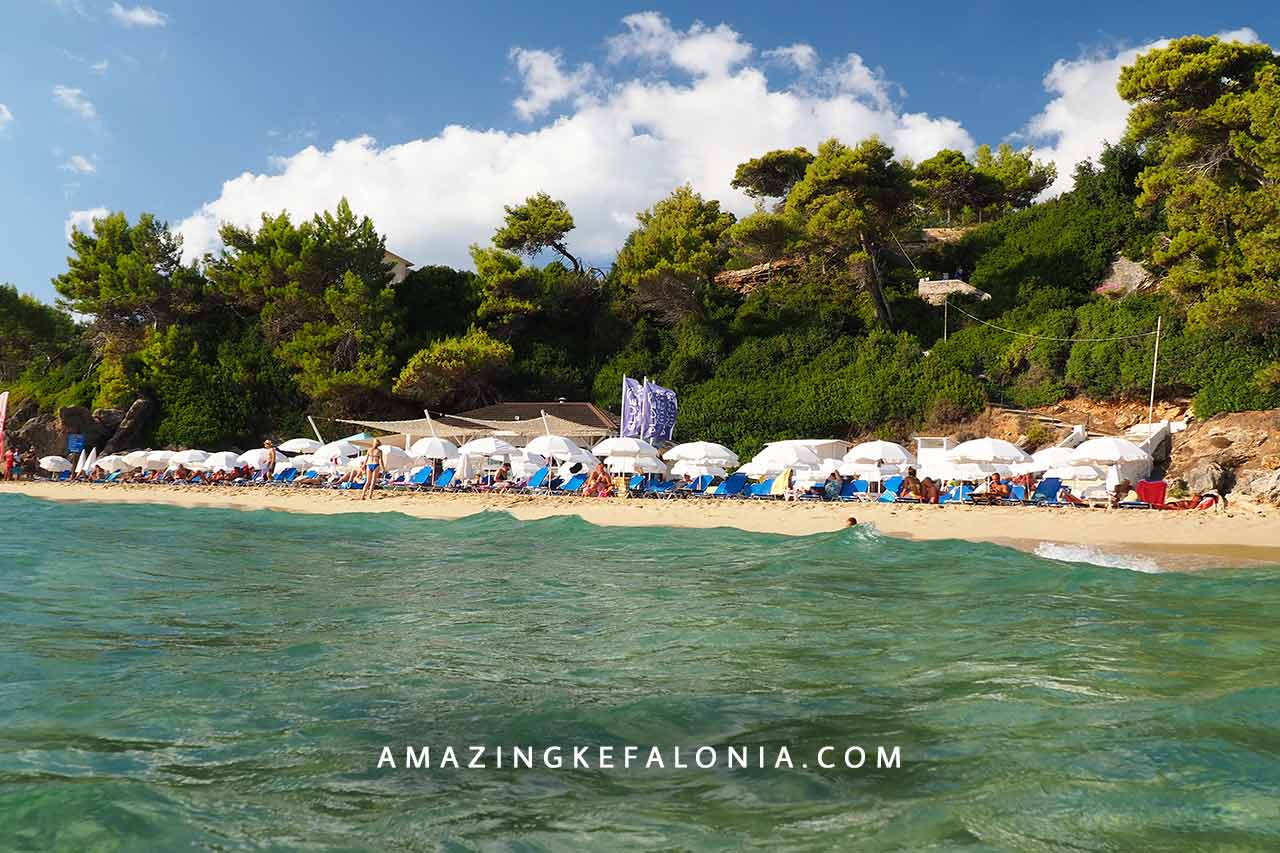
Weather of October in Kefalonia, transition to a mild autumn
October brings a noticeable shift toward autumn, with milder temperatures, occasional rain, and a change in the island’s landscapes.
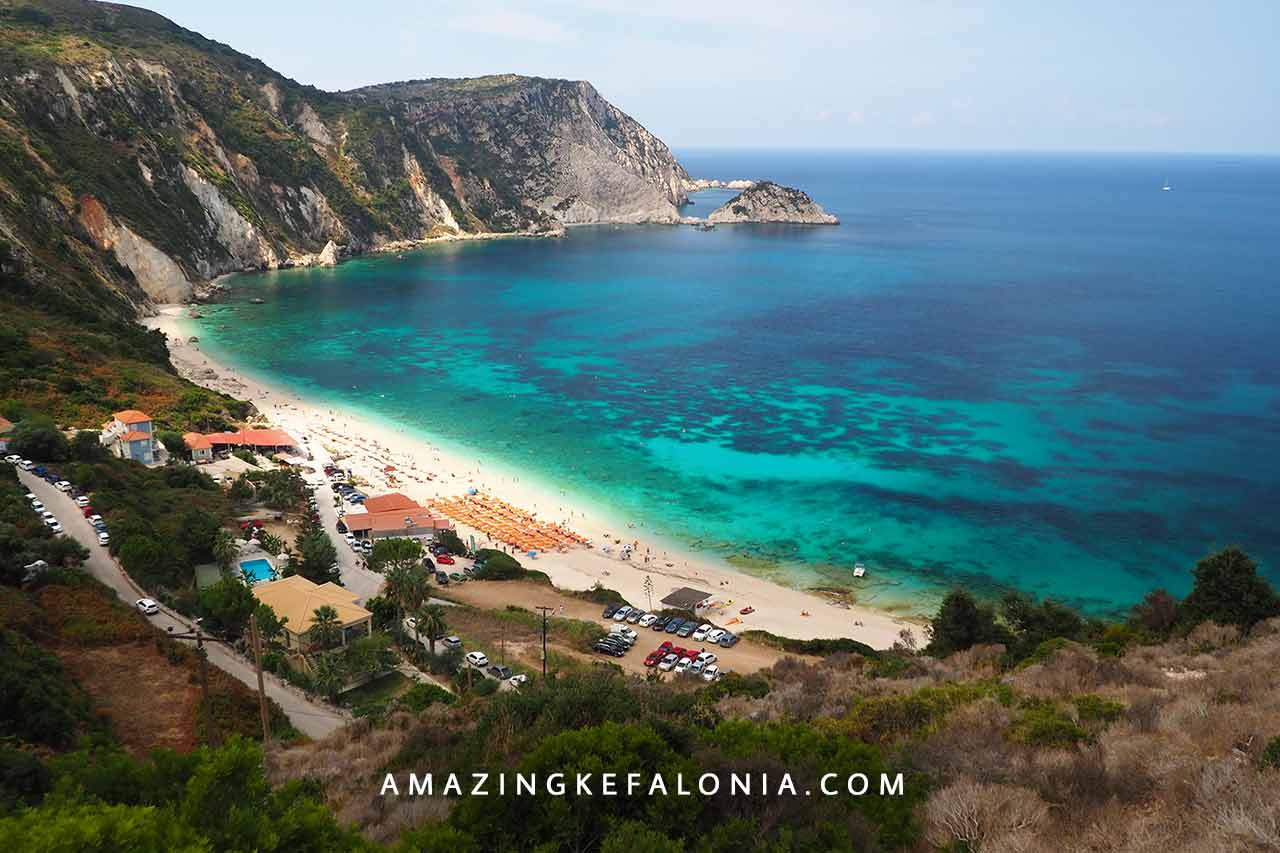
- Temperature: Highs range between 22°C and 26°C (72°F to 79°F), while nights cool down to 15°C to 18°C (59°F to 64°F).
- Precipitation: Rainfall increases gradually, with the occasional light shower and an average of about 60 mm for the month.
- Humidity: Humidity continues to rise, and the air feels fresher and cooler.
- Wind: Mild breezes from the southwest or west continue to blow, bringing some cooler air as autumn advances.
- Sunlight: Days are noticeably shorter, and cloud cover increases slightly, adding to the autumnal feel.
- Nature: The first hints of greenery start to appear as the island’s vegetation responds to the increased moisture. Vineyards and olive groves are lush with harvest-ready produce.
- Sea temperatures in October: average sea temperature: 22°C
By October, Kefalonia’s sea begins to cool down, averaging 22°C sea temperatures. However, the water is still warm enough for swimming for some people, especially earlier in the month. October is a transitional month where the sea retains the heat from the long summer but gradually releases it as air temperatures cool. This makes October popular among those who prefer quieter beaches but still want relatively warm waters.
Visitor Tips: the weather of october is ideal for a relaxed holiday, with fewer tourists and pleasant weather for sightseeing. The beaches are still inviting, and autumn festivals celebrating the grape and olive harvests add cultural depth to the island experience.
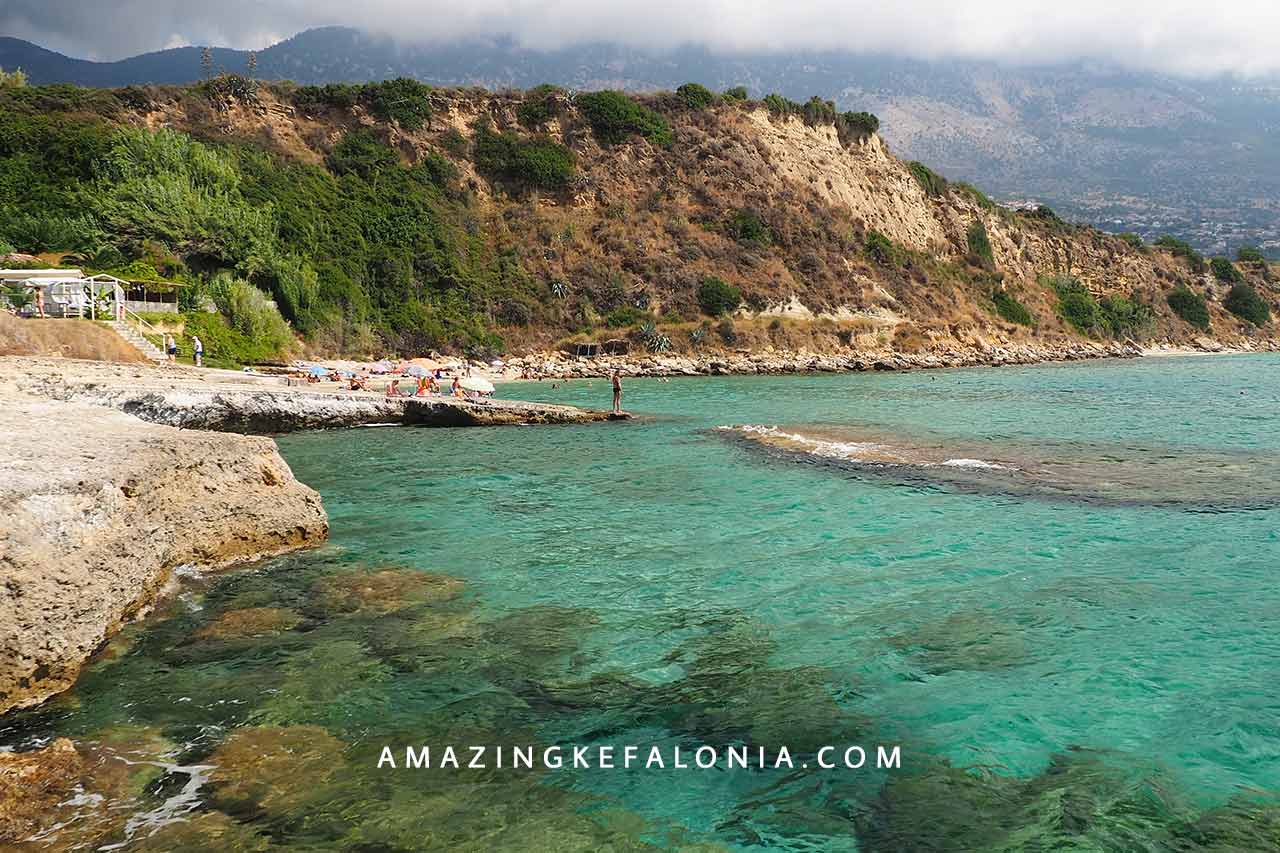
November weather with Cooler Days and Rainy Intervals
November marks the beginning of the island’s rainy season and cooler temperatures, setting the stage for winter’s approach.
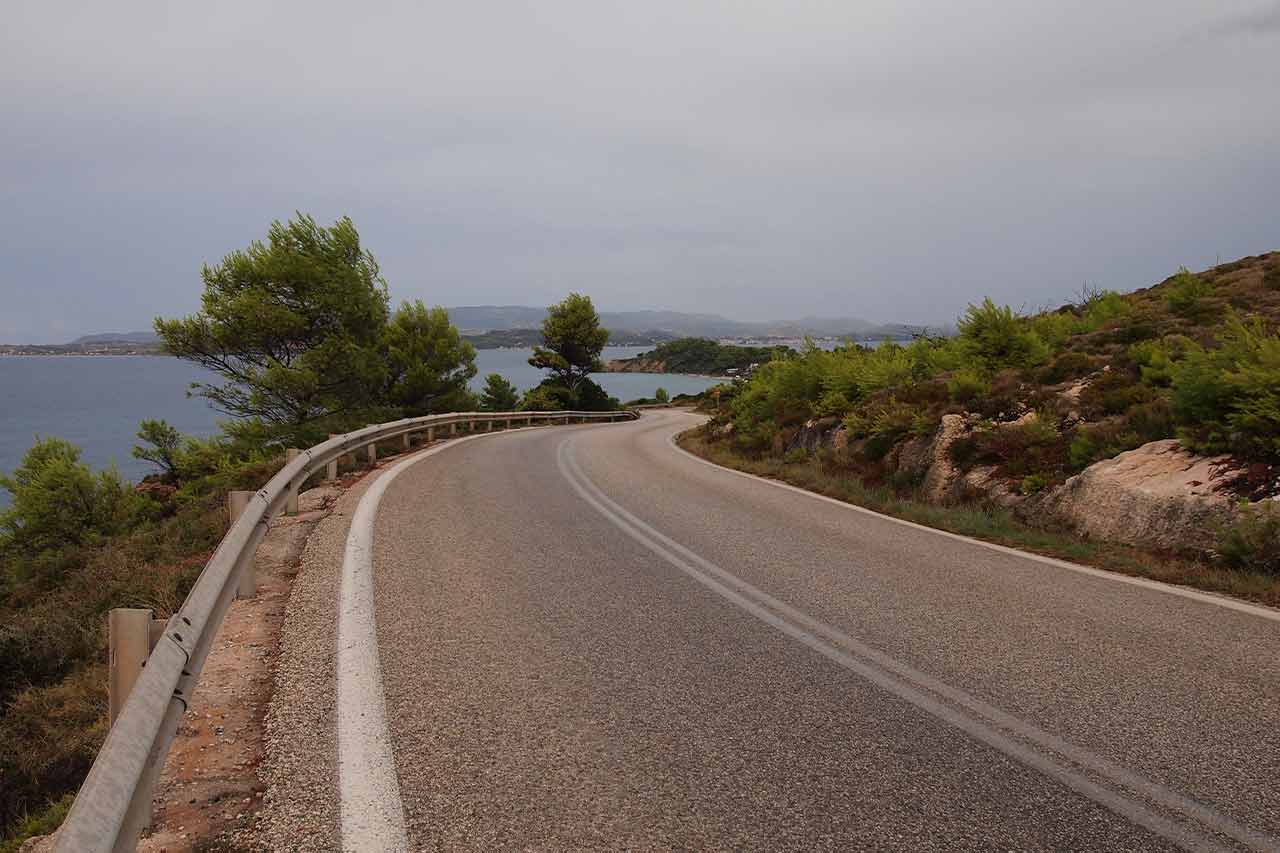
- Temperature: Highs reach 18°C to 21°C (64°F to 70°F), while nights cool to 12°C to 15°C (54°F to 59°F).
- Precipitation: Rain becomes more frequent, with November averaging 100 mm. Showers are common, especially toward the month’s end, contributing to the island’s green resurgence.
- Humidity: Humidity rises considerably due to the increased rainfall, bringing a damp feel to the air.
- Wind: Winds strengthen, mainly coming from the west or southwest, and occasionally bring gusty weather.
- Sunlight: Days are shorter, with cloudier skies, giving November a cozy, autumnal atmosphere.
- Nature: Vegetation flourishes as the island transforms into a vibrant green landscape. Wildflowers and herbs begin to grow, benefiting from the renewed moisture.
- Sea temperatures in November: average sea temperature: 19°C
In Kefalonia weather november brings more noticeable cooling, with sea temperatures around 19°C. The waters start to feel cooler, especially on days without sunshine. November’s cooler temperatures mark the end of the swim season for everyone in Kefalonia.
Visitor Tips for what to do in November: November is suitable for those who enjoy cooler weather and nature’s rejuvenation. The island is quieter, and visitors can enjoy scenic drives, coastal walks, and exploring quaint villages.
December in Kefalonia, when A Quiet, Rainy Winter Begins
December ushers in winter on Kefalonia, with mild but cool temperatures, frequent rain, and fewer hours of daylight. It’s a peaceful time on the island, ideal for a quieter, off-season retreat.
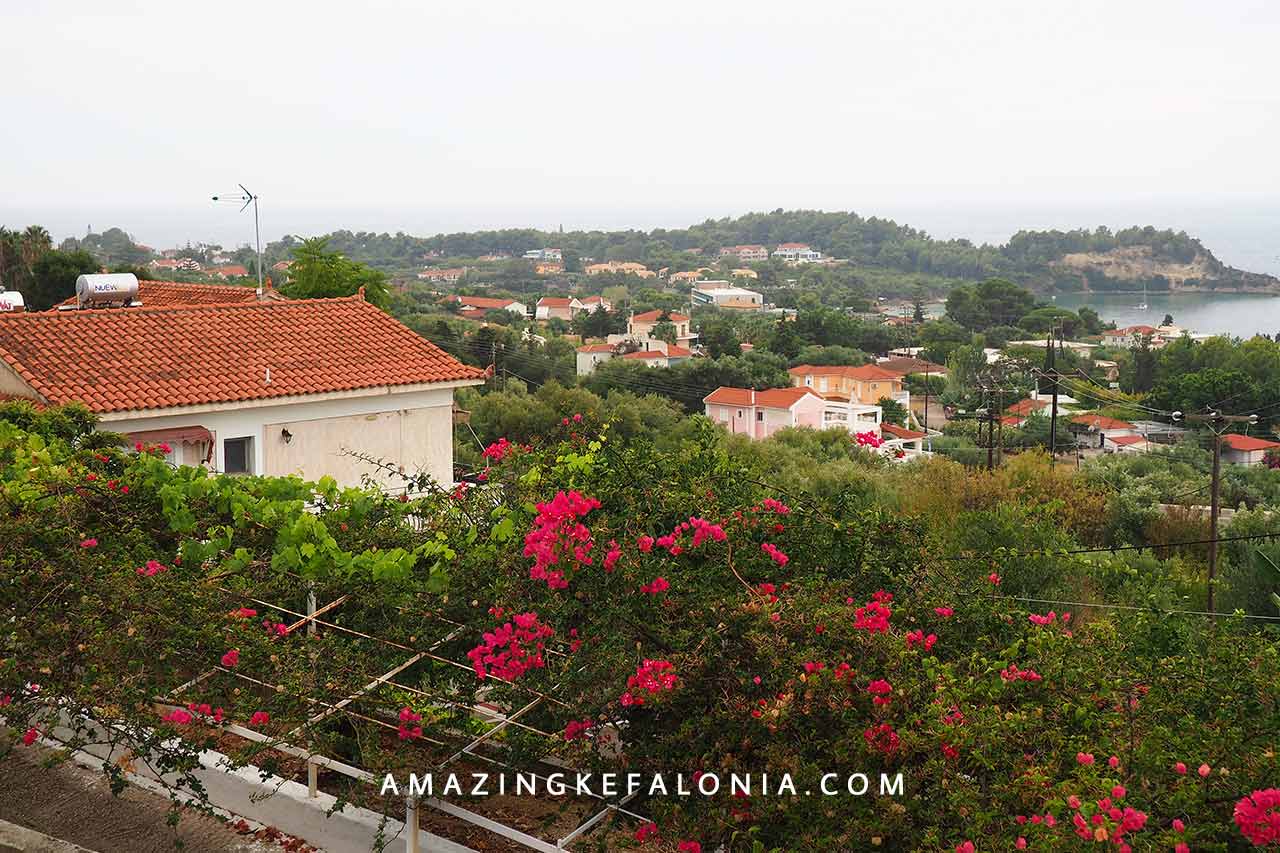
- Temperature: Daytime highs average between 15°C and 18°C (59°F to 64°F), with cooler nights around 10°C to 12°C (50°F to 54°F).
- Precipitation: December is among the rainiest months, with rainfall totals reaching around 120 mm. Showers are frequent, sometimes lasting a few hours, and contribute to the island’s lush winter greenery.
- Humidity: High humidity levels, close to 80%, give the air a distinctly damp feel, especially after rain.
- Wind: Winter winds from the northwest or southwest bring cooler air, occasionally creating choppy seas.
- Sunlight: December days are short and often cloudy, with brief sunny spells illuminating the island’s landscapes.
- Nature: Kefalonia is at its greenest, with hillsides covered in thriving vegetation. Moss, herbs, and winter wildflowers flourish, giving the island a fresh, rejuvenated appearance.
Visitor Tips fow what to do in December: December is perfect for a quiet retreat, with few tourists and a tranquil atmosphere. Exploring local culture, trying traditional winter foods, and visiting cozy tavernas are popular winter activities.
Unique Weather Patterns and Phenomena on Kefalonia
Mount Ainos’ Microclimate: Mount Ainos, the highest peak on Kefalonia, has its own unique weather, often cooler and mistier than the coastal areas. During winter, it’s not uncommon for Mount Ainos to receive light snowfall, a rare sight on a Greek island.
Ionian Winds: The Ionian Sea brings refreshing breezes to Kefalonia, especially during the summer. These winds are usually gentle, making summer temperatures more comfortable, but they occasionally bring stronger gusts, particularly in winter and early spring.
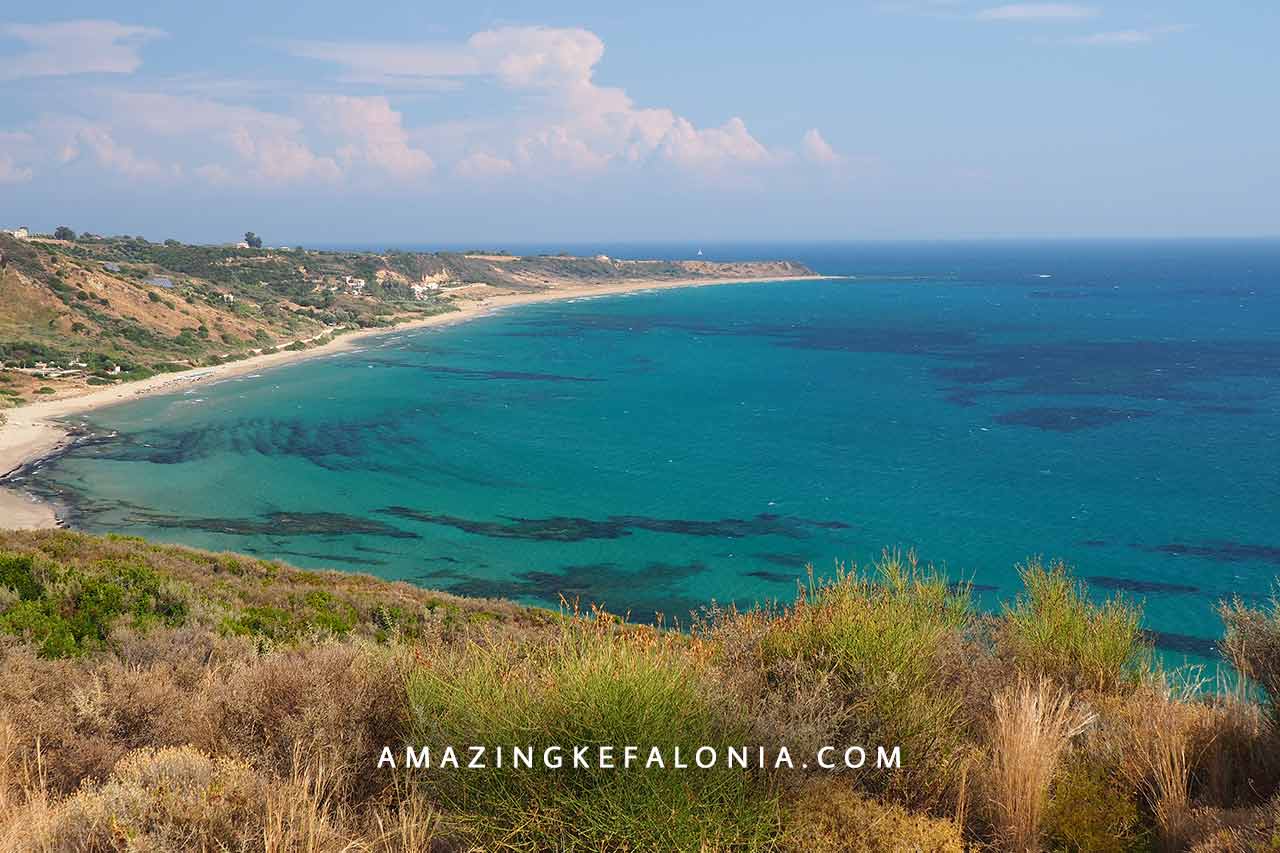
Stormy Skies in Winter: While Kefalonia doesn’t experience severe storms, winter months occasionally bring dramatic skies and rain squalls that lend a brooding beauty to the island’s coastal landscapes.
Planning Your Visit: Kefalonia’s Weather Tips, and best periods for travel
Best Time for Beach Holidays: June to early September is perfect for beach lovers, with warm temperatures, dry weather, and calm seas. The best sea temperatures of Kefalonia can be find from the end of June to early September.
Best Time for Hiking and Nature: Spring (March to May) offers ideal temperatures for outdoor activities, fewer crowds, and blooming landscapes. From the middle of September to the end of October there are also a lot of grat days, which are perfect for sightseeing, hiking and discover the best sights of Kefalonia island.
Best Time for Peaceful Retreats: Winter months, from December to February, offer a quiet, authentic Greek island experience, with cooler temperatures perfect for leisurely exploration.
In every season, Kefalonia’s climate shapes its appeal, from the tranquil, misty winters to the vibrant springs, the golden summers, and the refreshing autumns. Each period offers unique experiences, making Kefalonia a destination worth visiting year-round for anyone who appreciates the diverse beauty of the Ionian Islands.



